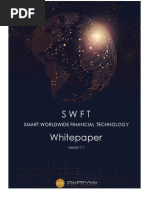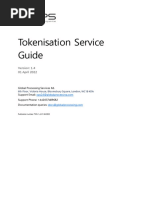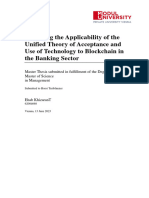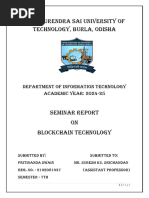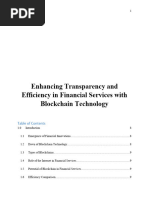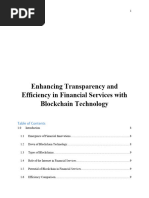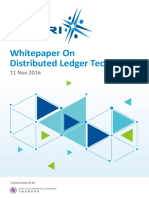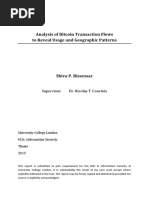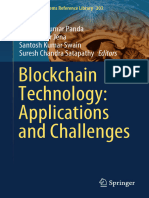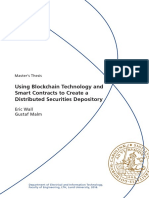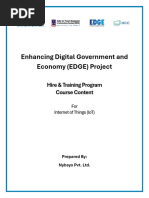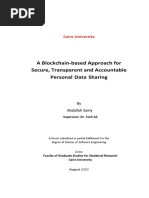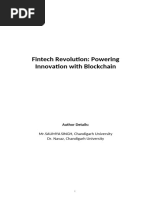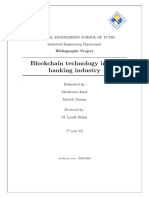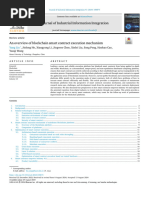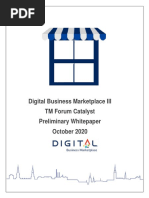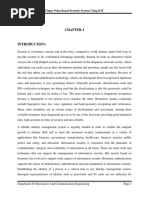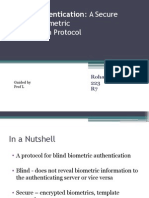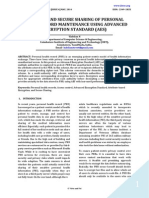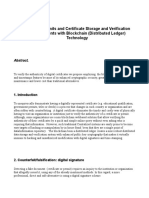White Paper V2.0
White Paper V2.0
Uploaded by
andreaCopyright:
Available Formats
White Paper V2.0
White Paper V2.0
Uploaded by
andreaOriginal Description:
Original Title
Copyright
Available Formats
Share this document
Did you find this document useful?
Is this content inappropriate?
Copyright:
Available Formats
White Paper V2.0
White Paper V2.0
Uploaded by
andreaCopyright:
Available Formats
Savitri Network
White Paper
Savitri Foundation – Andrea Cadamuro
v 2.0.0, May, 12, 2024
The first rule of any
technology used in a
business is that automation
applied to an efficient
operation will magnify the
efficiency. The second is that
automation applied to an
inefficient operation will
magnify the inefficiency.
Bill Gates
2 Savitri Foundation White Paper
Introduction
The Savitri project emerges at the forefront of the blockchain revolution, proposing a
transformative approach to how digital ecosystems are perceived, developed, and interacted
with. At the heart of Savitri lies a vision to harness the power of blockchain technology not just
as a foundation for cryptocurrencies but as a bedrock for a decentralized future where digital
interactions are secure, efficient, and accessible to everyone, regardless of their technical
expertise or geographic location.
Savitri is built upon the innovative Proof of Unity (PoU) consensus mechanism, a novel
approach designed to address the perennial challenges faced by existing blockchain
technologies—scalability, security, and environmental sustainability. By moving away from the
competitive nature of traditional consensus mechanisms, PoU fosters a collaborative
environment where nodes work together to secure the network and process transactions. This
paradigm shift not only facilitates faster transaction speeds and lowers costs but also ensures
a more democratic and inclusive blockchain ecosystem.
What sets Savitri apart is its unwavering commitment to integrating blockchain technology
seamlessly into daily life. The project goes beyond the technical intricacies to democratize
access to blockchain, making it a tool not just for financial transactions but for a myriad of
applications that can benefit from its underlying principles of transparency and immutability.
Through initiatives like the Savitri Foundation, the project endeavors to break down barriers to
blockchain adoption, offering educational resources, development support, and intuitive tools
to empower users and developers alike.
Savitri's vision is underpinned by a commitment to sustainability and decentralization. The
network's design supports smart contracts, IoT integration, and automated operations, laying
the foundation for a future where digital services and applications are not only secure and
transparent but also equitable and free from centralized control. This commitment extends to
fostering a collaborative ecosystem, inviting developers, entrepreneurs, and visionaries to
contribute towards a decentralized digital revolution.
As the digital world continues to expand at an unprecedented rate, the need for a blockchain
solution that is secure, scalable, and accessible becomes increasingly apparent. The Savitri
project represents a bold stride towards meeting this need, offering a beacon of hope for a
future where blockchain technology fulfills its revolutionary potential. By championing
innovation, collaboration, and inclusivity, Savitri is not just a blockchain project but a
movement towards a more secure, decentralized, and equitable digital future.
3 Savitri Foundation White Paper
Contents
1. Market Overview ................................................................................ 7
1.1. Market Strategy ................................................................. 8
2. Problem Overview ............................................................................ 10
2.1. Decentralized blockchains, face a series of inherent
challenges 10
2.2. Savitri is the solution of challenges of blockchain market . 11
3. Why Savitri ....................................................................................... 11
3.1. How did it start? ............................................................... 11
4. System architecture .......................................................................... 12
4.1. Network Layer.................................................................. 12
4.2. Savitri’s components ........................................................ 13
4.2.1. Node ................................................................................ 15
4.2.2. Master Node .................................................................... 16
4.2.3. Mechanism of consensus : Proof of Unity (PoU) ............... 17
4.2.3.1. The Receipt ...................................................................... 19
4.2.4. Block ................................................................................ 21
4.2.5. Monolith Block ................................................................. 22
4.2.6. Introduction of the Block fingerprint ................................ 23
5. Transactions...................................................................................... 25
5.1. Transaction Application .................................................... 25
5.1.1. Transactions Attachments ................................................ 25
5.1.2. Transactions Escrow ......................................................... 25
5.1.3. Fee transaction ................................................................ 26
5.1.4. Distribution of Rewards .................................................... 26
5.1.5. Calculating the Minimum Fee ........................................... 27
5.2. Introduction to Transaction Fee Calibration...................... 27
5.2.1. The Challenge of External Consensus................................ 27
5.2.2. Balancing Node Operator Incentives................................. 28
5.2.3. Implementing the Fee Scale Adjustment Mechanism ....... 28
5.2.4. Voting Phases for Fee Scale Adjustment ........................... 28
4 Savitri Foundation White Paper
5.2.5. Commitment Phase .......................................................... 28
5.2.6. Revelation Phase .............................................................. 28
5.2.7. Reward Schedule.............................................................. 29
5.2.8. Core Principles of the Reward Mechanism........................ 29
5.2.9. Linear Reward Distribution Formula ................................. 29
5.2.10. Innovative Selection of Reward Recipients ....................... 29
5.3. Multi Sign on Savitri ......................................................... 30
5.3.1. Multisig Addresses ........................................................... 30
5.3.2. Multisig Info Object .......................................................... 30
5.3.3. Multisig Transaction Type................................................. 30
5.3.3.1. Use Cases ......................................................................... 31
5.4. Liquid Payment ................................................................ 31
5.4.1. Revolutionizing Payments with Smart Contracts ............... 31
5.4.2. Ensuring Liquidity and Operational Continuity .................. 31
5.4.3. Integration with External Applications .............................. 31
6. IoT integration .................................................................................. 32
6.1. Solution 1: IoT Devices as Network Nodes ........................ 32
6.2. Solution 2: Direct Blockchain Connection ......................... 33
7. Hydra Solution .................................................................................. 34
7.1. What Does Hydra Technology Offer? ................................ 34
7.2. How Does Normal Operation Resume?............................. 34
7.3. Why Is Hydra Revolutionary? ........................................... 35
7.3.1. Detection of Network Disruption ...................................... 35
7.3.2. Activation of Limited Functionality Mode ......................... 35
7.3.3. Use of the Monolith Block ................................................ 35
7.3.4. Resumption of Full Network Operations ........................... 36
7.3.5. Continuous Monitoring and Adaptation ........................... 36
8. CDS : Crypto Default Swap ................................................................ 36
8.1. Introduction ..................................................................... 36
8.2. How the Service Works .................................................... 36
8.3. Problems Resolved by the Service .................................... 37
8.3.1. The CDS addresses several critical issues faced by
cryptocurrency investors: .................................................................. 37
5 Savitri Foundation White Paper
8.4. Benefits for Users ............................................................. 37
8.4.1. Investors utilizing the Crypto Default Swap gain multiple
advantages: ....................................................................................... 37
9. Savitri Tokenomics: An In-Depth Look at SAVI .................................. 38
9.1. Detailed Distribution of SAVI ............................................ 38
9.2. Enhancing Token Value and Supply Control in Savitri: The
Strategic Burning Mechanism ............................................................ 39
9.3. Educational Outreach and Platform Knowledge................ 40
9.4. Strategic Collaborations for Ecosystem Expansion ............ 40
9.5. Comprehensive Marketing and Brand Positioning ............ 40
9.6. Developer Support and Network Growth ......................... 41
9.7. Fostering Global Adoption and User Accessibility ............. 41
10. Examples of Savitri’s Use Cases. ....................................................... 42
10.1. Use Case 1: Decentralized Finance (DeFi) Platform ........... 42
10.2. Use Case 2: Supply Chain Transparency ............................ 42
10.3. Use Case 3: Secure IoT Network ....................................... 43
11. Conclusion ........................................................................................ 44
12. Roadmap .......................................................................................... 47
Glossary ................................................................................................... 48
References ............................................................................................... 51
6 Savitri Foundation White Paper
1. Market Overview
In the rapidly evolving landscape of blockchain technology, the market is ripe with
opportunities and challenges. As of now, blockchain technology is not just a buzzword but a
critical infrastructure for numerous industries, offering solutions for secure, transparent, and
efficient transactions. The global blockchain market, growing at an unprecedented rate, is
projected to reach billions of dollars in value within the next few years. This growth is fueled by
the increasing adoption of blockchain in finance, supply chain, healthcare, and more,
highlighting its potential to revolutionize traditional business models.
However, the path to widespread adoption is not without obstacles. Issues such as scalability,
security, and user accessibility continue to hamper the full potential of blockchain technologies.
Additionally, the environmental impact of certain consensus mechanisms, like Proof of Work,
has raised significant concerns.
In this dynamic market, Savitri positions itself as a game-changer. By addressing these
challenges head-on with its innovative Proof of Unity (PoU) consensus mechanism, Savitri offers
a more secure, scalable, and environmentally friendly blockchain solution. With its focus on
accessibility and integration into everyday life, Savitri is poised to drive blockchain technology
beyond its current financial applications, making it a foundational element for a wide range of
digital solutions.an inclusive community through active engagement on social media, forums,
and blockchain events. Offering incentives for community contributions, such as development,
testing, and content creation, can further encourage participation..
7 Savitri Foundation White Paper
1.1. Market Strategy
To capitalize on the burgeoning blockchain market and navigate its complexities, a
comprehensive and reliable market strategy is essential, especially for a non-profit foundation
like Savitri. Here's how Savitri plans to make its mark:
1. Educational Initiatives: Increasing blockchain awareness and understanding is crucial
for adoption. Savitri will launch educational programs and workshops targeting both
developers and the general public to demystify blockchain technology and highlight
its potential beyond cryptocurrencies.
2. Partnerships and Collaborations: Establishing strategic partnerships with key
industry players across various sectors, including finance, healthcare, and supply
chain, can showcase the practical applications of Savitri's blockchain. Collaborating
with academic institutions for research and development can also enhance the
network's credibility and utility.
3. Community Engagement: Building a strong, engaged community is vital for the
success of any blockchain project. Savitri plans to foster an inclusive community
through active engagement on social media, forums, and blockchain events. Offering
incentives for community contributions, such as development, testing, and content
creation, can further encourage participation.
4. Sustainability Focus: With environmental concerns becoming increasingly important,
Savitri's eco-friendly PoU mechanism provides a competitive advantage. Highlighting
this aspect in all communications will appeal to eco-conscious investors and users.
5. Innovation and Development Grants: Offering grants and funding to developers for
innovative applications built on the Savitri blockchain can stimulate creativity and
utility, driving the network's growth and adoption.
6. Open-Source Development: Emphasizing the open-source nature of Savitri
encourages collaboration and transparency, attracting developers and ensuring the
continuous improvement of the platform.
7. Market Positioning and Branding: Clearly articulating Savitri's unique value
propositions, such as its democratic consensus mechanism, scalability, and
integration capabilities, is essential. A strong branding strategy that resonates with
both technical and non-technical audiences will help Savitri stand out in a crowded
market.
8 Savitri Foundation White Paper
of the most important
project blockchain layer 1
9 Savitri Foundation White Paper
2. Problem Overview
In the current blockchain ecosystem, a range of critical issues hampers the full realization
of its revolutionary potential. These challenges, encompassing centralization and security,
scalability and transaction costs, accessibility, adoption, and environmental sustainability,
demand innovative solutions. Savitri's vision proposes transformative approaches to tackle
these issues, positioning itself as a pioneer in the next generation of blockchain technology
tools to broaden user adoption.
,.
2.1. Decentralized blockchains, face a series of inherent
challenges
Scalability: One of the primary issues with decentralized blockchains is their limited ability
to process a high volume of transactions quickly and efficiently compared to centralized
systems. As the number of users and transactions grows, the network can become congested,
leading to slower transaction times and higher fees.
• Energy Consumption: Certain consensus mechanisms, like Proof of Work (used by
Bitcoin), require substantial computational power and energy consumption. This
has raised environmental concerns and sparked a debate on the sustainability of
such blockchain networks.
• Security: While decentralized blockchains are generally secure, they are not
immune to attacks. For instance, a 51% attack, where a single entity gains control
of the majority of the network's mining power, can threaten the network's integrity.
There's also the risk of smart contract vulnerabilities.
• Interoperability: Many blockchain networks operate in silos and lack the ability to
communicate with one another. This limits the potential for widespread adoption
of blockchain technology, as seamless interaction between different blockchains is
crucial for many applications.
• Regulation and Legal Challenges: The decentralized nature of blockchain poses
regulatory challenges. Jurisdictions around the world are still figuring out how to
regulate cryptocurrencies and blockchain technology, leading to a landscape of
legal uncertainty for users and developers.
• Usability and Accessibility: For many users, blockchain and cryptocurrency
technologies remain complex and difficult to understand. This usability barrier
hinders adoption among the general public, who may benefit from blockchain
technology's offerings.
• Centralization Tendencies: Despite the decentralized ideal, there is a trend towards
centralization in certain aspects of blockchain ecosystems, such as mining pools in
Proof of Work blockchains or the concentration of wealth and voting power in Proof
of Stake systems. This can lead to unequal power dynamics within supposedly
decentralized networks.
10 Savitri Foundation White Paper
• Data Privacy: Public blockchains are transparent, meaning transactions are
visible to everyone. This poses privacy concerns for users who may not want
their financial transactions or interactions to be publicly accessible.
2.2. Savitri is the solution of challenges of blockchain
market
Savitri tackles key challenges facing today's blockchain technology with innovative
solutions. Central to its strategy is the Proof of Unity (PoU) consensus mechanism, designed to
combat the trend towards centralization by fairly distributing authority across all nodes,
enhancing network security and promoting inclusive governance. By optimizing transaction
processing. Savitri addresses scalability and transaction cost issues, enabling faster speeds and
lower costs without compromising on security or decentralization. The project also focuses on
making blockchain technology more accessible and user-friendly, through initiatives like the
Savitri Foundation, which provides educational resources and intuitive tools to broaden user
adoption.
Furthermore, Savitri is committed to environmental sustainability, with its PoU
mechanism requiring significantly less energy than traditional Proof of Work systems. This
reflects a broader vision for blockchain as a foundation for new applications, from decentralized
finance to secure data management, aiming to make blockchain as integral to digital services
as the internet today. With an emphasis on inclusivity and sustainability, Savitri aspires to
leverage blockchain for global challenges like financial inclusion and a low-carbon economy.
Savitri's layer-1, open-source, decentralized network, powered by PoU, stands out as faster,
cheaper, more democratic, and eco-friendly, marking a significant step towards a secure,
scalable, and sustainable digital future.
3. Why Savitri
Savitri stands as a beacon in the blockchain technology landscape, promising a revolution
in the world of decentralized networks. This white paper highlights why Savitri is the
cornerstone choice for developers, investors, and users seeking innovative, secure, and
democratic solutions in the realm of cryptocurrencies and blockchain technology. Savitri is
more than a blockchain; it's a movement towards a decentralized digital revolution, inviting
developers, entrepreneurs, and visionaries to contribute to shaping a future where technology
enhances freedom, security, and community. Through collaborative effort and innovative
solutions, Savitri aims to redefine the landscape of blockchain technology, making it a tool for
positive change in the digital age.
In conclusion, Savitri represents not just a response to the current challenges of blockchain
technologies but also a bridge to a future where blockchain and cryptocurrencies play a central
role in technological innovation, digital security, and global economic empowerment. Choosing
Savitri means embracing a vision of the future where blockchain technology serves humanity,
making the digital world a safer, fairer, and more inclusive place.
3.1. How did it start?
11 Savitri Foundation White Paper
Savitri was born in 2021, rooted in an idea and a dream that had been nurtured through
years of research: to create a truly decentralized network capable of solving today’s persistent
issues. Currently, many blockchains that started with decentralization in mind are increasingly
moving towards becoming federated systems, or in some cases, centralized. This shift is largely
due to the prohibitive costs for ordinary individuals to become active members and the
minuscule rewards they receive. These challenges are leading to greater centralization in the
hands of large investors, whether through mechanisms like Proof of Stake (PoS), Proof of Work
(PoW), or other models.
For this reason, we developed Savitri, a network and a consensus mechanism called Proof
of Unity (PoU) designed to change the paradigm from a completely competitive system to a
collaborative one. In our network, nodes are not meant to compete but to collaborate in order
to reach consensus. Moreover, we have also shifted the paradigm regarding the creation of
fees. We do not believe in centralization, fixed fees, or percentages, as the value can vary
significantly over the long term. Hence, we have introduced a different logic: a fee management
system based on the agreement among all network nodes, which will have the right to vote
once a month to define the fees.
This model is aimed at addressing the centralization issues faced by current blockchain
technologies, promoting a more inclusive and equitable framework. By emphasizing
collaboration over competition and introducing a democratic fee system, Savitri is poised to
redefine the landscape of blockchain networks. Our commitment to innovation and
decentralization reflects our vision for a more accessible and balanced digital future. Join us in
this journey towards creating a truly decentralized network that solves the challenges of
today’s blockchain technologies.
4. System architecture
4.1. Network Layer
The Savitri blockchain operates through a network of interconnected nodes, including the
Savitri-node and masternode. This software is versatile, functioning as a core block producer, a
relay, or a local access point to the network. The node is comprised of various interconnected
components, ensuring seamless operation and connectivity within the Savitri ecosystem.
• The settlement layer: The settlement layer is primarily concerned with the ownership
and transfer of assets over the blockchain. It’s where are defined the rules of Savitri
• The data layer: in a blockchain refers to the foundational level that handles how data
is structured and stored across the network. It’s one of several layers that make up
the architecture of blockchain technology, each with its own distinct functions and
responsibilities.
• The consensus layer: in a blockchain is crucial for ensuring that all participants in the
network agree on a single, truthful version of the ledger without the need for a
central authority. It’s what makes Savitri technology so revolutionary for creating
trust in a decentralized system.
• The Execution Layer: in a blockchain refers to the component responsible for
executing transactions and smart contracts according to the rules and logic defined
12 Savitri Foundation White Paper
within them. This layer processes the instructions contained in each transaction,
ensuring they are carried out correctly on the blockchain.
4.2. Savitri’s components
Node:
In the dynamic landscape of the Savitri blockchain ecosystem, a node represents a fundamental
building block, serving as the backbone of the network's decentralized architecture. Nodes are
individual computers or servers that connect to the Savitri blockchain network, playing a crucial
role in maintaining the network's integrity, security, and accessibility. Each node possesses a
complete or partial copy of the blockchain, ensuring redundancy and resilience against data
loss or manipulation.
Operating a node on the Savitri blockchain is both a privilege and a responsibility, allowing
participants to contribute directly to the network's operation. It represents a commitment to
the principles of decentralization, transparency, and security that are foundational to
blockchain technology. Node operators, through their dedication and collective effort, enable
the Savitri blockchain to function as a secure, scalable, and decentralized platform, ready to
support a wide array of applications and innovations.
Masternode:
Within the Savitri blockchain ecosystem, a Masternode is a key infrastructure component that
plays a crucial role in enhancing network functionality, security, and governance. Unlike
standard nodes that primarily support basic transaction verification and block propagation,
Masternodes are empowered with additional responsibilities and capabilities, making them
pivotal to the network's overall performance and resilience.
Masternodes are highly trusted and resource-committed nodes that require a significant stake
in the network's native token to operate. This staking mechanism serves a dual purpose: it
incentivizes the provision of high-quality services by the Masternode operators and secures the
network against malicious actors. The elevated requirements and responsibilities of
Masternodes ensure that only dedicated and invested participants contribute to critical
network operations.
Proof of unity
Proof of Unity (PoU) is an innovative consensus mechanism employed in the Savitri blockchain,
designed to tackle the challenges of security and centralization plaguing traditional blockchain
networks. Unlike competitive models like Proof of Work (PoW) or Proof of Stake (PoS), PoU
fosters a collaborative environment where network nodes work together to ensure security,
streamline operations, and minimize environmental impact.
The mechanism is based on the equitable distribution of authority and participation across all
nodes, democratizing access and governance of the network. This approach not only speeds up
transaction processing and reduces associated costs but also encourages broader participation
in the network, ensuring it remains open and accessible to everyone.
PoU is crucial for achieving true decentralization, addressing the issue of power concentration
in the hands of a few entities or individuals that could compromise network security. Moreover,
PoU's design aims at a balance between energy efficiency and performance, positioning Savitri
as an eco-sustainable blockchain solution.
13 Savitri Foundation White Paper
In summary, Proof of Unity represents a significant advancement in blockchain consensus
mechanisms, offering a more secure, fair, and sustainable platform for decentralized
applications.
Block:
In the Savitri blockchain, a "Block" is a fundamental component that represents a set of
recorded transactions and data, securely linked together in a chronological chain. Each block
contains a comprehensive record of multiple transactions that have occurred within the
network at a given time, along with a reference to the previous block, thereby forming an
immutable sequence known as the blockchain.
The structure of a block in Savitri is meticulously designed to ensure the integrity, security, and
traceability of data. It comprises the block header, which includes essential metadata such as
the cryptographic hash of the previous block, a timestamp, and the block's own hash value.
This ensures each block is uniquely identifiable and securely anchored within the blockchain's
history, preventing unauthorized alterations.
Moreover, blocks in Savitri are created through a consensus mechanism known as Proof of
Unity (PoU), which emphasizes collaboration over competition among network participants.
This innovative approach not only enhances the efficiency and scalability of transaction
processing but also significantly reduces the environmental impact associated with traditional
blockchain consensus models.
In essence, a block within the Savitri blockchain is more than just a data container; it is a
cornerstone of digital trust, enabling transparent, secure, and decentralized transactions across
the network. This design facilitates a wide range of applications, from financial transactions to
complex smart contracts, making Savitri a versatile platform for the next generation of
blockchain technology.
Monolith Block
In the Savitri blockchain ecosystem, the Monolith Block stands as a pioneering architectural
element designed to streamline network efficiency and accessibility. Unlike traditional blocks
that contain transactional data or smart contract executions, the Monolith Block serves a
specialized function by encapsulating a comprehensive snapshot of the network's state at
regular intervals. This includes an updated registry of active nodes and masternodes, ensuring
that participants have immediate access to the most current network configuration.
Created daily, the Monolith Block facilitates a seamless entry for new nodes, enabling them to
quickly synchronize with the network's current state without the need to process the entirety
of the blockchain's history. This is particularly beneficial for maintaining high levels of network
scalability and performance, as it significantly reduces the bandwidth and storage requirements
for nodes joining the network.
The structure of the Monolith Block is meticulously engineered to include only the essential
information required for network synchronization, making it remarkably lightweight compared
to standard blocks. This design choice not only expedites the onboarding process for new nodes
but also minimizes the computational load on the network, contributing to the overall
sustainability and efficiency of the Savitri blockchain.
By incorporating the Monolith Block into its architecture, the Savitri blockchain addresses
common challenges associated with blockchain scalability and node synchronization. This
innovative approach underscores Savitri's commitment to fostering an accessible, efficient, and
scalable blockchain ecosystem, paving the way for a more inclusive and dynamic digital future.
14 Savitri Foundation White Paper
4.2.1. Node
Node Registration Simplified:
In our network, while anyone can run a node and join the network, only a select group of nodes
has reached the highest score in the round can create blocks and receive Savi Coin. The process
for a node to become registered or to be removed from the registry is governed entirely by the
network’s rules, without any single user or authority having control over these decisions. This
approach is designed with three main goals in mind:
• Enhancing Security: To safeguard against the theft of private keys and to prevent
attackers from compromising the network by taking control of a majority of nodes.
• Maintaining Network Integrity: To ensure that only productive nodes, or those not
exploiting the network in unforeseen ways, remain active and eligible for rewards.
• Regulating Node Participation: To manage how new nodes join the network and to
remove inactive or non-contributing nodes efficiently.
Here’s how we address each goal:
• Separating Private Keys: Unlike systems where block creation requires the node
operator’s private key to be on the node itself, potentially exposing it to theft or
attack, we keep the private key separate from the block creation process. This
minimizes the risk of key theft from online nodes, especially those hosted on virtual
private servers (VPS), where data center operators might otherwise access the keys.
• Controlling Node Registration: To prevent an attacker from overwhelming the
network by registering a multitude of nodes simultaneously, our protocol limits the
number of new nodes that can join the registry within a certain period. This control
helps to prevent a single entity from gaining a majority control of the network.
• Removing Inactive Nodes: Through a scoring system, our Proof of Unity algorithm
identifies and removes nodes that are offline or not actively participating. Nodes with
a zero score are automatically ejected from the registry but can rejoin once they
become active again.
Field Description
The public key corresponds to the node’s configured private key. When blocks
or Proof of Unity messages are produced by a node, the signatures can be
Public Key validated against this key.
The account address of the node owner’s account. This account may legally
change or remove the node registration, and any participation rewards earned
Account Address by the node are credited to this account.
An amount of funds that the node’s owner has put up as collateral to compete
for a spot in the registry, and to incentivize her to maintain the security of her
Locked Balance node’s private key.
A score tracked for this node over time by the Proof of Unity algorithm. A higher
score increases the number of rewards received, while falling to zero will cause
Participation Score the node to be ejected from the registry.
15 Savitri Foundation White Paper
The Node’s Public Key and Security
Each node in the Savitri network maintains a private key to sign blocks, ensuring transactions
and messages are authentically from the node. This private key, ideally stored securely on the
node’s device, can also be managed through a separate hardware device for enhanced security.
This measure is crucial because if a node’s private key is compromised, it risks impersonation
and potential loss of locked funds by attackers.
Locked Balance for Registry Maintenance
To be part of the registry, a node owner locks a certain amount of Savitri tokens. These funds
are deducted from the owner’s account and held by the network as a security deposit. If a node
is removed or voluntarily exits the registry, these funds are fully returned. The size of the locked
balance plays a role in prioritizing the node’s position in the registration queue, serving as a
deterrent against Sybil attacks without relying solely on Proof of Stake principles.
The Registration Queue
Nodes awaiting registry entry are placed in a registration queue, ordered by the amount of
their locked funds. Admissions from the queue to the registry occur at regular intervals, with
the pace adjusted based on the registry’s size to maintain network security.
Registering a Node
Registration involves submitting a transaction with the node’s public key, a proof of ownership
(a special message signed by the node’s private key), and the locked fund amount. This
transaction, higher in fee to prevent abuse, locks the specified funds and adds the node to the
queue.
Claiming a Node
In case a node’s private key is lost or compromised, the node can be claimed to recover locked
funds, though this action removes the node from the registry. This mechanism aims to balance
security concerns, ensuring that while nodes are safeguarded against unauthorized control,
owners are incentivized to maintain strict security practices.
Ejection and Re-Entry
Nodes may be ejected from the registry if they become inactive but can re-enter the queue
without additional fees, provided they re-establish activity. This process ensures that only
actively participating nodes remain in the registry, supporting the network’s integrity.
Simplified Management with Savitri
Savitri simplifies this entire process, from registration to management and security of nodes,
ensuring that participants can easily maintain their nodes with minimal technical expertise.
Through the use of a user-friendly wallet application, node owners can effortlessly manage
their registrations and secure their contributions to the network’s Proof of Unity, a novel
approach replacing the traditional Proof of Participation to ensure a more unified and secure
network operation.
4.2.2. Master Node
The masternode in the Savitri blockchain network plays a critical role by providing enhanced
capabilities beyond those of standard nodes. Its primary functions include storing the entire
blockchain history and creating what is referred to as a "monolith block." This special type of
block is designed to simplify access to the network for new nodes, which only need to download
the headers of the blocks to verify transactions. Initially, the functionality of masternodes to
16 Savitri Foundation White Paper
confirm transactions is being utilized within the DevNet, highlighting their importance in
maintaining network efficiency and security.
Enhanced Capabilities: Masternodes are distinguished from standard nodes by their ability to
perform additional tasks that are crucial for the network's functionality:
• Creation of Monolith Blocks: Masternodes generate a daily 'monolith block' that acts
as a comprehensive ledger, listing all network participants, including nodes and
Masternodes. This feature significantly enhances the functionality of Masternodes
within the Savitri ecosystem.
Registration and Activation: Becoming a Masternode involves a registration process similar to
that of standard nodes. Users must install the necessary software on their device and complete
a registration transaction that involves sending a specified amount to the network to secure
their Masternode status.
• Activation: After registration, the Masternode enters a queue until it is approved by
the existing Masternode network. Once activated, Masternodes earn rewards based
on their staked amount, duration of activity, and quality of performance. Rewards
are distributed twice daily to those active for at least two weeks, with factors such as
the token amount, hours processed, and a daily performance score influencing the
reward size.
• Monolith Block: A Network Overview: The monolith block offers a verifiable
snapshot of the network's structure and participants, which is crucial for maintaining
transparency and accountability. Its generation ensures that the state of the network
is accurately recorded, aiding in the review and verification processes.
• Strategic Importance: Masternodes play a pivotal role in the Savitri blockchain
beyond just facilitating transactions and governance. They safeguard the network's
integrity and historical record, which is essential for keeping the blockchain secure,
transparent, and well-managed.
• Removal of Masternodes: Masternodes may be removed due to reasons such as
inactivity, a self-request, or by other Masternodes for poor performance or malicious
activity. Depending on the reason for removal, the staked amount may be returned
or, in cases of malicious actions, distributed among all network participants as
rewards.
In summary, Masternodes are integral to the functionality, security, and efficiency of the Savitri
blockchain network, offering advanced features that support the overall stability and integrity
of the digital ecosystem.
4.2.3. Mechanism of consensus : Proof of Unity (PoU)
Proof of Unity (PoU) represents an innovative concept in the blockchain world, aiming to
optimize the transmission of data such as blocks and transactions through a peer-to-peer (P2P)
system among nodes. This method stands out for its ability to facilitate timely communication
between numerous nodes without the need for a central tracking entity. Instead, it uses a
temporary ledger present in each node to track transactions automatically and randomly upon
their reception.
Our goal with this method is to improve network reliability by encouraging the constant
availability of nodes; we wanted to change the paradigm from a system in which nodes
compete to a new system in which nodes cooperate, the scope is to create a distribute network
where the responsibility of maintaining the blockchain’s history more broadly across various
participants, and to fairly reward all contributing nodes. Furthermore, this strategy incentivizes
the network’s registered nodes to self-organize into an efficient structure, reducing the path
17 Savitri Foundation White Paper
data needs to travel for widespread dissemination.This approach promotes a robust, equitable,
and high-performing network, ensuring that participation is both incentivized and essential for
the ecosystem’s health and growth.
Transmission and Tracking Mechanism
In the Proof of Uunity (PoU) framework, whenever a node receives a transaction, it starts a
communication procedure with other nodes, which are randomly chosen from its internal list.
This process involves forwarding the transaction to a selected node and then awaiting a
confirmation response. This confirmation is provided in the form of a receipt, which not only
acknowledges that the transaction was received but also provides a score that indicates the
success level of the transaction transmission. If the transaction is not approved, the receipt will
serve as evidence of this rejection.
Commitments and Transmission Proofs
To ensure the system’s integrity, nodes are required to regularly publish “commitments”
documenting their transmission activity. This ensures that transmission records are pre-existing
and cannot be fabricated on the spot. When a sample of past transmission activity is requested,
the node must demonstrate that such records were included in the commitments already
published on the blockchain, making it impossible to create them retroactively.
Transmission Receipts and Commitments
Every transmission within the Savitri network generates a digital receipt, signed by the
recipient, uniquely identifying the participants and the moment of transmission. These receipts
include a commitment in the form of a Merkle root, which in turn aggregates other receipts
previously collected. The inclusion of these receipts in a block allows for an objective validation
of the node’s transmission activity, influencing its participation score.
Age Filter and Network Topology
The system imposes an age filter on receipts, determining their expiration after a certain
number of blocks to emphasize recent network activity. This expiration time varies based on
the number of active nodes, adjusting to the average time between block creations.
Furthermore, the Savitri network periodically updates its topology to determine from which
peers a node can receive and publish receipts, ensuring an equitable distribution of
participation opportunities among all nodes.
18 Savitri Foundation White Paper
Figure 1 Sequence Merkle tree on Proof of Unity
4.2.3.1. The Receipt
Generating and collecting receipts
In the Savitri network, when one node sends data like a transaction or block to another, the
receiver, upon verifying the data, generates a receipt to acknowledge the transfer. This process
is done even if the data was previously received from a different source, provided it is valid.
Here’s a simplified breakdown of how it works:
• Generating Receipts: After receiving and validating data, the receiving node creates a receipt.
This receipt includes:
The sender’s public key (who sent the data).
The receiver’s public key (its own).
The type of data (block, transaction, etc.).
The hash of the data.
19 Savitri Foundation White Paper
The current block height and hash from the receiver’s
perspective.
The vote from different parameters
Merkle Root Inclusion:
The receiver adds a Merkle root from its batch table to the receipt. While other nodes can’t
directly check this, it’s crucial for the receiver to accurately include this for future validations of
data transmissions.
Signing and Returning:
The receiver signs the receipt with its private key to certify its creation and sends it back to the
sender. If a node consistently fails to return valid receipts, it risks being blacklisted.
Organizing Receipts:
When nodes send data, they collect receipts from those who receive them. These receipts are
grouped into batches and each batch has a Merkle root representing the combined evidence
of those transactions.
Batch limits:
There is a limit to the number of receipts that can be included in a single Merkle root,
encouraging nodes to discard receipts that will not be useful for future proofs, such as those
that do not align with peer filters.
Scoring: In Proof of Unity, scoring is the key aspect of block allocation, this together with the
lottery will incentivise teamwork. The score is calculated according to several parameters some
examples are:
Amount of coins blocked
Amount of time the node has participated in the network
Quality of data
Timeliness of transmission
Volume of data transmitted
Contribution with votes for network choices
Database storage and finalisation:
Receipts are stored in memory until the node is ready to finalise a batch. The node calculates
the Merkle root for the batch and stores this information in the database, linking it to the block
height in which it was created. Each receipt within the batch is also saved, labelled with the
Merkle root of the batch and its sequence number in the batch.
This method allows nodes to keep track of their interactions within the network, preparing
them to prove their active participation and support the network’s Proof of Unity. This process
ensures a transparent and accountable network, promoting efficiency and integrity in data
propagation.
In the Savitri network, nodes share data as transactions or blocks and confirm these
transmissions through receiving objects. This is how the process is simplified and made secure:
Receipt production:
When one node sends data to another, the recipient, after confirming its validity, generates a
receipt. This receipt includes details such as the public keys of the sender and receiver, the data
type, the hash of the data, the height of the reference block and the hash of that block. It also
contains a Merkle root related to the data batch, which helps in subsequent validations.
Receipt Management:
20 Savitri Foundation White Paper
The nodes collect these receipts in batches, calculating a Merkle root for each one to aid future
verification processes. Receipts that are unlikely to be needed for future verification can be
discarded, optimising storage and focusing on relevant data exchanges.
Remove old receipts:
Receipts expire after a certain period, depending on the block height indicated within them.
Nodes periodically remove these expired receipts to maintain a lean and efficient database,
ensuring that the system’s memory footprint remains constant.
4.2.4. Block
In contrast to centralized systems where client requests are processed in a sequential manner,
decentralized systems, like peer-to-peer networks, allow users to submit data through any
node, leading to transactions being received in varying orders by different nodes.
Blockchain technology addresses the challenge of establishing a consistent order for all
transactions disseminated across the network. Through a pseudo-random selection process,
nodes are tasked with adding groups of transactions, known as blocks, to the collective
transaction history of the network. Each block, containing transactions and additional data, is
securely linked to the preceding block using cryptographic hashes in its metadata, forming a
chain — hence the term “blockchain.” This linkage means altering any block’s data would
necessitate the reconstruction of all following blocks, ensuring the integrity of the transaction
history.
Figure 2Block's Components
Structure of a block
Unlike centralized systems where tasks are done one by one, decentralized systems, such as
peer-to-peer networks, let users send information through any of the system’s parts. This
means that transactions can arrive in different orders at different places.
Blockchain technology solves the problem of how to put all these transactions in a specific order
across the whole network. It does this by selecting nodes in a sort of random way to group
transactions into blocks. These blocks, which hold transactions and some extra information, are
21 Savitri Foundation White Paper
then linked together in order. Each block is connected to the one before it by special codes
called cryptographic hashes, creating a chain — that’s why it’s called “blockchain.” If you
wanted to change information in one block, you’d have to change all the blocks that come after
it, which helps keep all the transaction records safe and unchanged.
Block creation and protection from modification.
In the context of the Savitri blockchain, the process of block creation and its protection from
undue modification are key aspects in ensuring the security and integrity of the network. The
creation of a block in a blockchain is an operation that, if not properly controlled, could leave
room for manipulation by block creators, thus compromising the entire system.
Hash Function and Entropy
The hash function plays a crucial role in block creation, producing a unique hash value from a
set of input data. This function is designed to generate output that appears as uniformly
distributed random numbers, independent of the input data. Although a block hash may seem
like a good source of entropy, i.e. randomness, exploiting it in such a way can be dangerous. An
attacker, having the possibility of altering certain elements of the block such as transaction
order, timestamp or other data, could repeatedly attempt to modify the block until a
‘favourable’ hash is obtained that would allow him to manipulate the blockchain.
4.2.5. Monolith Block
The Savitri blockchain incorporates a unique feature known as monolith blocks, designed to
streamline the process of accessing the blockchain’s history. These special blocks are created
once daily and are linked sequentially to the previous monolith block, forming a chain that
allows nodes to leapfrog over regular blocks from the genesis block to the current moment.
This system facilitates rapid access to any point in the blockchain’s history, making it a
lightweight and efficient way to maintain an updated ledger of node registry changes.
Monolith blocks are generated on average once a day and primarily record significant updates
to the node registry, such as the addition or departure of nodes, along with other metadata.
Importantly, they do not contain transaction data, resulting in a very light set of blocks for
download. This design ensures that a node needs to download only a minimal amount of data
for each day of the blockchain’s existence, providing an always up-to-date list of nodes in the
registry at any historical moment. Consequently, this allows nodes to verify if the next monolith
block was created by a legitimate node and make informed decisions in the event of a fork.
22 Savitri Foundation White Paper
Figure 3 Monolith Block
Bootstrapping a New Node
The initial step for a new node involves downloading all monolith blocks from the genesis block,
choosing the set of blocks with the highest cumulative difficulty in the event of a fork, until it
reaches the latest available monolith block. The node then uses the hash of the most recent
blockchain snapshot found in a spine block to identify and download a snapshot of the
blockchain from network peers. This process enables a new node to quickly update itself with
the blockchain’s current state within minutes, significantly reducing the time and resources
needed to become a fully participating member of the network.
This innovative approach to blockchain architecture not only enhances the efficiency of
accessing historical data but also simplifies the process for new nodes to join and synchronize
with the network, ensuring the Savitri network remains robust, secure, and accessible.
4.2.6. Introduction of the Block fingerprint
The calculation of the block fingerprint is done through a formula that guarantees its
unpredictability and uniqueness:
new_block_seedH=hash(creator_signatureH(hash(block_fingeprintH-1+block_metadataH)))
Where:
– new_block_fingerprintH is the seed of the current block we are calculating.
– creator_signatureH is the digital signature of the creator of the current block, applied to the
combination of the hash of the previous block’s seed and the current block’s metadata.
– block_fingerprintH-1 is the seed of the previous block.
– block_metadataH includes additional data of the current block, such as the block number,
timestamp, and hash of the current block’s header, thus increasing the entropy of the seed.
Process Description
Data Combination: Instead of directly signing the seed hash of the previous block,
the block creator combines this hash with the metadata of the current block. This
step introduces an additional layer of unique data that makes the seed more
unpredictabApplication of the
Digital Signature: The block creator applies its digital signature to the combination
of the seed hash of the previous block and the metadata of the current block,
ensuring that the seed cannot be generated without the creator’s private key.
Calculation of the Final Hash: Finally, the hash of the signature result provides the
new seed of the block. This step ensures that the final seed is a fixed hash value
23 Savitri Foundation White Paper
that is independent of the length of the signature, uniformly distributed and
difficult to predict without knowing the signature and the initial data.
Use of the Digital Signature Algorithm Ed25519
Savitri adopts the Ed25519 digital signature algorithm for creating block seeds, known for its
efficiency and security. A key advantage of Ed25519 is that there is only one possible signature
per message and per private key. This eliminates the possibility for the block creator to choose
between several potential signatures, forcing him to accept the block seed generated by the
protocol without the possibility of alteration.
Block creation:
Within the context of “node registration,” where the complete set of potential block creators
is known, Savitri employs a method that, following each block, pseudo-randomly generates a
priority-ordered list of nodes tasked with creating the next block. If a node fails to produce a
block when it’s their turn (due to being offline, network issues, or voluntary omission), its
participation score is decreased. In such cases, the network waits for a block from the next
node in the randomly ordered list.
Alternative algorithm for block creator selection:
To make the block creator selection process more resilient and distributed, an algorithm based
on “weighted voting” and “commitment” concepts could be considered. In this scenario, every
node in the network can participate in the selection of the block creator through a voting
mechanism that accounts for not only the presence of the node but also its reliability and
contribution to the network.
Algorithm Definition:
Commitment Weight Calculation (CWC): Each node commits a certain amount of resources
(e.g., computing power, storage, bandwidth) for a specified period. This commitment is
measurable and is used to calculate a “Commitment Weight” for each node.
NodeWeight = f(resourceCommitment)
Where f is a function that maps resource commitment into a numerical weight.
Weighted Voting: When it’s time to select the block creator, every node participates in a voting
process. The vote of each node is weighted based on its Commitment Weight, with nodes that
have committed more resources having more weight in the decision.
Block Creator Selection:
A unique hash value for the last confirmed block is calculated, serving as the seed for
the pseudo-random selection.
Using the seed, the block creator is selected based on the weighted distribution of
votes.
blockCreator = pseudoRandomSelection(hash(lastBlock), weightedDistribution)
Failure to Create Handling: If the selected node fails to create the block within a predetermined
time, its Commitment Weight is reduced, affecting its future selection capability. The selection
process is then repeated excluding the failed node.
This algorithm aims to incentivize nodes to maintain a high level of commitment and reliability,
as their ability to influence the block creator selection and earn rewards is directly proportional
to their commitment to the network.
24 Savitri Foundation White Paper
5. Transactions
Every action executed on the Savitri blockchain by a user is encoded in a transaction that
specifies the action the nodes should take, the action parameters and and data payload, and
has all this digitally signed using the sender’s private key. A transaction may be as simple as
transferring tokens from one account to another but could have unlimited complexity, so long
as its core application logic satisfies the properties that both the transaction validation and its
execution are purely deterministic operations which only read from, and write to, the portion
of each node’s database managed by the consensus algorithm.
When a transaction is first received from a peer or from a wallet software, the node will first
confirm that the transaction is legal. This includes validating that the transaction is closed by a
valid digital signature for its sending account address and that the parameters of the
transaction are valid according to the transaction type’s rules and the current state of the
database (such as having enough balance to send funds).
If the transaction received is valid, the node will propagate the transaction by transmitting it to
other connected peers, as well as store the transaction in its local mempool. In this way, valid
transactions are echoed across the peer-to-peer network until they are retained in the
mempool of the majority of nodes. Upon receiving a valid transaction, each node will also
return a special object we call a receipt to the sender. Receipts are used in the Proof of Unity
algorithm described below.
5.1. Transaction Application
When a node receives and validates a new block (described in the section on “blocks” below),
it will contain an ordered list of zero or more transactions, which the node will then apply in
sequence.
For a node, applying a transaction means executing the rules associated with the transaction’s
type to update its local database from an old state to a new state. In the simplest example, this
can mean deducting the balance from one account and adding it to another.
5.1.1. Transactions Attachments
In future versions of Savitri, transactions will be allowed to specify large attachments to be
stored in a distributed file system by the network. While the transaction itself must be
propagated to all nodes, the attachment may only need to be propagated to a few nodes
responsible for storing the file for others to download. More details on this are given in the
section below on File Distribution.
5.1.2. Transactions Escrow
When two parties must swap goods online, it is often useful to have a trusted third party keep
the goods in escrow, such that the swap is only executed when both parties have committed
their assets. Traditionally, this trusted third party holds both of the assets, and if they are not
in fact so trustworthy, they may abscond with both. Therefore, it is useful to have a system in
which the trusted third party may only approve or reject the transfers between parties, but in
no case becomes the owner of the assets.
To facilitate this use case, Savitri users may optionally include in the transaction the account
address of an approver, which may either accept or reject the application of the transaction.
Transactions which require approval are kept in an “escrowed” state by the blockchain, such
that the funds or other assets they confer ownership of cannot be used by either the sender or
25 Savitri Foundation White Paper
the receiver until the explicit approval or rejection is completed, or the timeout returns control
of the assets to the sender.
The transaction may also specify:
• a custom timeout: the number of blocks until, or the date/time at which, the transaction is
automatically rejected (by default 1 day). The maximum timeout is 1 month;
• commission: an amount of tokens which will be paid to the approver if he accepts/rejects
the transaction before the timeout, by default, the cost of a transaction;
• instructions for the approver: in binary or a JSON format if the approver is an application
on a server, or in a human language if the approver is a regular user of Savitri;
• the behavior for when the transaction timeout: automatically approve or reject.
In the case that the timeout is reached before the approver sends an approval or rejection, the
transaction is automatically approved or rejected and the commission is returned to the
sender.
In order to approve or reject an escrowed transaction, the specified approver must broadcast
an approval transaction, referencing the hash of the pending escrowed transaction and
specifying whether he approves or rejects it. While the approval transaction can be submitted
automatically by centralized services, when a user needs to manually submit the approval for
a transaction, the technical complexities are hidden by the wallet UI.
One use case of such an escrow mechanism would be to configure a centralized server which
manages an approver account and which is programmed to automatically approve transactions
only when certain conditions have been met. For example, an escrowed transaction may
specify that it should only be approved once 10 Ethereum have been transferred to a particular
ETH account and set the approver to be a server which will monitor the Ethereum network to
determine whether to release the funds.
Alternatively, any account may be configured to require explicit approval to accept any
transaction addressed to it. In this case, if an approver account is not specified, the recipient
account automatically becomes the approver. The rest of the mechanics defined above apply
in exactly the same way, with the receiver of the transaction functioning as the approver.
To achieve the current normal behavior of blockchain transactions, any transaction which does
not specify an approver account, and for which the receiver is not configured to require
approval to accept transactions, is applied immediately upon its acceptance in a block.
The owner of an account may at any time enable or disable this mandatory approval behavior
on the account by broadcasting the desired account property setting with a required approval
transaction and specifying whether mandatory approval is enabled (default is “no”).
5.1.3. Fee transaction
Transaction fees in blockchain and cryptocurrencies are costs paid to validators for processing
transactions. Usually these fees vary based on network congestion, transaction complexity, and
confirmation speed. Every transaction in Savitri requires the payment of a fee in SAVI coin. This
practice serves to cover the costs of executing transactions on the network and to protect the
blockchain from potential spam attacks, making it economically impractical to overload the
network with an excessive volume of transactions.
5.1.4. Distribution of Rewards
The fees collected, along with the new Savi coins issued for each block, are shared among the
network’s registered nodes. This system not only rewards nodes for their network
contributions but also encourages block creators to include as many transactions as possible to
maximize the overall reward.
Each Masternode receives a reward from the network for every block it stores. This allocation
is made randomly, but Masternodes with higher scores and longer network activity times are
26 Savitri Foundation White Paper
given a greater chance of receiving rewards. This method motivates nodes to improve both the
quality and quantity of their work to increase their chances of earning rewards from the
network.
5.1.5. Calculating the Minimum Fee
The minimum fee for each transaction depends on the type of transaction being processed. To
determine this fee, a specific formula is used that considers both the transaction type and a
scaling constant. This scaling constant is adjustable and may be periodically updated to mirror
the current state of the network, ensuring that fees remain fair and reflect network demand.
Transactions that pay a fee higher than the minimum requirement are often processed more
quickly. This is particularly true during times of high network congestion, where the incentive
for faster processing increases with higher fees. Essentially, by offering to pay more than the
minimum fee, users can prioritize their transactions, allowing them to be confirmed more
swiftly in busy periods.
This fee structure serves multiple purposes: it helps regulate the flow of transactions through
the network, preventing spam and ensuring that resources are allocated efficiently. Moreover,
it provides a mechanism for users to expedite their transactions when needed, offering
flexibility and improved user experience in times of high demand.
Here’s our algotithm for calculate the base fee:
min_fee(TxA) = base_fee(TxTypeA) + congestion_fee(NetworkStatus) +
urgency_fee(TxUrgency)
Where:
• base_fee(TxTypeA): A base fee determined by the type of transaction A.
• congestion_fee(NetworkStatus): An additional fee that varies with the current level of
network congestion. This is calculated as a percentage of the base fee or a fixed amount that
increases as the network becomes more congested.
• urgency_fee(TxUrgency): An optional fee that users can add to their transaction to
prioritize it over others. This is a fixed fee or scale with the level of prioritization requested.
5.2. Introduction to Transaction Fee Calibration
In the realm of decentralized systems, determining transaction fees poses a significant
challenge. On one end, a centralized approach where a trusted third party sets the fee based
on new information against a pre-agreed public key of the entire blockchain could be
considered. However, this method contradicts the principles of decentralized systems, as it can
be manipulated by a single actor beyond accountability. On the opposite end, nodes
independently sourcing public data, such as the token’s value from exchanges to align
transaction fees with a stable currency value, risks causing forks due to inconsistency in external
data when queried by different nodes at various times.
5.2.1. The Challenge of External Consensus
Achieving a secure consensus on external data, such as a token’s value relative to other
currencies, is inherently complex within a blockchain framework. Automatic resolution of such
consensus cannot be realized due to the decentralized nature and the variability of external
data sources. This presents a dilemma for maintaining transaction fees consistent with a stable
currency value amidst the fluctuating value of the blockchain’s principal token.
A Node-Operated Voting System for Fee Scale Adjustment
27 Savitri Foundation White Paper
To address this issue, we propose a system where registered node operators on the network
can regularly vote on the appropriate multiplier, which we term the “fee scale,” for minimum
transaction fees. This system aims to maintain the transaction fee value constant relative to a
stable currency, even as the main token’s value varies. Entrusting such a critical network
parameter to node operators is potentially risky, and a more comprehensive discussion of this
risk is intended for future work. However, we favor this approach over the inherent risks
associated with imposing a static minimum fee for the reasons outlined above.
5.2.2. Balancing Node Operator Incentives
We believe the risk associated with the node-operated voting system can be mitigated by
balancing two opposing incentives that should limit each other. On a small scale, a node
operator desires to maximize transaction fees collected in each block by pushing the network
fee scale higher. However, on a larger scale, high network fees may deter users from conducting
transactions on the blockchain, affecting usability and potentially reflecting on the token’s
price. This, in turn, influences the real value a node operator can earn, incentivizing them to
lower the network fee scale.
5.2.3. Implementing the Fee Scale Adjustment Mechanism
The fee scale adjustment based on voting is realized through three mechanisms: node
operators commit to their votes, reveal votes they previously committed, and employ a
calculation of the mean to determine the new network fee scale. This process ensures a
democratic and balanced approach to adjusting transaction fees, aligning with the
decentralized ethos of blockchain systems while addressing the practical need for stable
transaction costs.
5.2.4. Voting Phases for Fee Scale Adjustment
The process of adjusting the fee scale within a decentralized network involves a structured
voting mechanism. This mechanism is divided into two main phases: the Commitment Phase
and the Revelation Phase. Each phase plays a crucial role in ensuring the integrity and security
of the voting process.
5.2.5. Commitment Phase
During the Commitment Phase, node operators submit their votes on how the network’s fee
scale should be adjusted, if at all. This is done through a commitment vote transaction, which
creates a fee vote object. This object contains a recent block hash, the corresponding block
height, the user’s vote on the new network fee scale, and the digital signature of the account
over these pieces of information. Including additional details in the fee vote object (such as the
block hash and account signature) is crucial for making the vote object’s hash resistant to
attacks where an attacker might guess the fee scale a user is voting for.
5.2.6. Revelation Phase
Following the Commitment Phase is the Revelation Phase, where votes are recorded on the
blockchain and tallied. In this phase, registered node operators are allowed to send a revelation
vote transaction. This transaction includes the full content of the fee vote object previously
committed by the user. The transaction must be signed and sent to the network, and for nodes
to accept it as a valid transaction, the hash of the submitted fee vote object must match the
commitment hash previously sent by the user during the Commitment Phase.
This two-phase voting process ensures that votes are cast securely and anonymously in the
initial phase, with integrity verified in the subsequent phase. It’s designed to prevent
manipulation and ensure that each vote genuinely reflects the operator’s intentions regarding
the network fee scale adjustments.
28 Savitri Foundation White Paper
5.2.7. Reward Schedule
The Savitri network is proud to introduce a cutting-edge approach to reward distribution,
meticulously designed to transcend the limitations of traditional block reward halving
mechanisms. Our strategy ensures a smooth and predictable decrease in rewards over a 50-
year timeline, fostering equitable distribution among all network participants. This premier
solution is tailored to maintain network health and encourage continuous engagement.
5.2.8. Core Principles of the Reward Mechanism
Our reward distribution model is elegantly simple yet profoundly effective, utilizing a linearly
decreasing reward system over five decades. This method guarantees a steady reduction in
rewards, enabling participants to forecast their potential earnings with high accuracy, thus
ensuring stability and predictability in the network’s economy.
5.2.9. Linear Reward Distribution Formula
The heart of our reward mechanism is encapsulated in the following formula:
RewardH=InitialReward−((InitialReward/TotalBlocksIn50Years)×H)
This formula demonstrates our commitment to a transparent and fair approach, where:
InitialReward represents the reward for the initial block.
TotalBlocksIn50Years estimates the total blocks produced over the span of 50 years.
H indicates the height of the current block.
5.2.10. Innovative Selection of Reward Recipients
To democratize the reward process, we’ve devised a system that judiciously balances each
node’s contribution to the network with an element of randomness. This dual-factor selection
process ensures that every node, regardless of its tenure, has a fair opportunity to be rewarded,
thus promoting network growth and vitality.
29 Savitri Foundation White Paper
The Selection Formula
We employ a distinctive formula to calculate each node’s score for reward eligibility:
ScoreN=RandomFactor+[1/(1+ActivityLevelN)]
Nodes with the lowest scores are prioritized for rewards, ensuring a fair and inclusive system
that values contribution and participation equally.
Implementation and Impact
The linear reward calculation ensures the minting of tokens is aligned with the target
supply, avoiding excess and promoting long-term sustainability.
Our selection mechanism for reward recipients is crafted to encourage consistent
participation while also drawing new nodes to the network, striking a perfect balance
between rewarding loyalty and fostering growth.
5.3. Multi Sign on Savitri
When managing valuable digital assets, it’s risky to rely on a single individual holding the
account key, as it might be lost or compromised. To enhance security, we use multi-signature
(multisig) features. This allows the creation of accounts that need a certain number of
signatures from a group to authorize transactions. For instance, in a group of 10 people, any 4
can sign to approve a transaction.
Figure 4 Multi-sign transaction
5.3.1. Multisig Addresses
These are special addresses created from a hash of details, known as multisig info, defining who
can sign transactions. This setup keeps signer identities private until needed.
5.3.2. Multisig Info Object
MinSigs: Minimum signatures required to execute a transaction.
Nonce (“Access Code”): A unique number to differentiate multisig addresses with the same
participants.
Addresses: A list of account addresses authorized to sign, sorted alphabetically. These can also
be multisig addresses, allowing for a hierarchy.
5.3.3. Multisig Transaction Type
Savitri handles multisig through a single transaction type, accommodating both on-chain and
off-chain behaviors without revealing signer identities prematurely. The transaction includes
30 Savitri Foundation White Paper
optional components: multisig info, the transaction details (or its hash), and signatures from
co-signers.
Nodes manage multisig operations using three tables: multisig info, pending transactions, and
pending signatures. Transactions are executed once all necessary components are present and
valid, maintaining anonymity until execution.
5.3.3.1. Use Cases
Off-Chain Multisig: Similar to traditional multisig, where a transaction prepared off-
chain is broadcast for immediate network validation.
On-Chain Multisig: Allows for sequential on-chain signature collection, useful when
not all signers can coordinate off-chain.
Anonymizing Multisig Addresses: Keeps asset controllers anonymous until action is
needed, with the option for many to submit signatures for plausible deniability.
Concealing Pending Transactions: Protects transaction details until enough support
is gathered, enhancing privacy.
Hierarchical Multisig: Supports complex organizational decision-making structures,
allowing for multiple layers of multisig requirements.
This simplified approach ensures asset security and flexibility in transaction authorization,
catering to various operational needs while preserving privacy and integrity.
5.4. Liquid Payment
In the modern era of web services, the necessity for automated payment systems for salaries
or allowances is increasingly becoming a critical requirement. Traditional blockchain
transactions have a significant limitation: each transaction must be manually initiated and
confirmed via a digital signature. This manual approach is perceived by our foundation as a
constraint that diminishes the blockchain’s application potential. To address this issue, we are
pioneering a technology that facilitates automatic payments through the use of smart
contracts.
5.4.1. Revolutionizing Payments with Smart Contracts
Our innovative approach leverages smart contracts to automate the payment process without
locking funds within the wallet. This technology allows for the configuration of automatic
payment orders contingent upon the availability of sufficient funds in the user’s wallet. Unlike
traditional methods, this system provides flexibility and control to the user, who can halt
payments at any moment. Upon the suspension of a payment, the smart contract will
automatically notify the recipient about the payment block.
5.4.2. Ensuring Liquidity and Operational Continuity
One of the paramount features of our technology is its ability to seamlessly handle liquidity
issues. Should the wallet lack the necessary funds for the automated payment, the smart
contract is designed to automatically terminate the payment order. This feature ensures
operational continuity and financial stability without requiring manual intervention, thereby
streamlining the payment process.
5.4.3. Integration with External Applications
Furthermore, our solution is designed to complement, not overhaul, the existing operational
models of external applications. By merely adapting to communicate with smart contracts,
external applications can easily integrate with our automated payment system. This
compatibility allows for a smooth transition and adoption of blockchain technology for
automated transactions, eliminating the need for significant changes to their current
operational procedures.
31 Savitri Foundation White Paper
6. IoT integration
The Savitri Network project emphasizes the seamless integration of IoT (Internet of Things)
devices into the network, allowing these devices to directly transmit data to the network
without intermediaries. Addressing this challenge involves two potential solutions: treating
each IoT device as a distinct network node capable of creating digitally signed transactions, or
alternatively, establishing a direct connection with the blockchain.
6.1. Solution 1: IoT Devices as Network Nodes
The first solution involves registering each IoT device as a separate node within the network.
By doing so, IoT devices are empowered to actively participate in network operations,
generating and dispatching digitally signed transactions akin to any other node. This approach
leverages the network’s existing security protocols to authenticate and log data sent from IoT
devices, ensuring secure and verifiable communication.
Figure 5 Scheme 1st Solution
1. Creating a Digital Authentication Server: Utilize an open-source service such as
Keycloak to establish a digital authentication server. This server will manage access
and identity for users and devices interacting with the blockchain.
Integration with Keycloak
2. Keycloak Integration: a. Configure Keycloak to interface with the data submission
component to the blockchain. This may involve leveraging authentication and
authorization protocols like OAuth 2.0 to facilitate secure communication between
Keycloak and the blockchain data submission component.
Implementing a Custom IoT Component or Service
3. Custom Component or IoT Service Implementation: Implement a customized
component or an IoT service (e.g., MQTT Mosquitto) that facilitates the interaction
between IoT devices and the blockchain network.
32 Savitri Foundation White Paper
IoT Node Functionality
4. Functionality of the IoT-Connected Node: Ensure that the node connected to the IoT
service is capable of: a. Digitally signing data to maintain integrity. b. Associating data
with a wallet, a public key, and the address of the smart contract representing its
identity on the blockchain. c. Sending data to the blockchain through transactions. d.
Upon submission, the blockchain recognizes and validates the transaction.
Monitoring and Management
5. Monitoring and Management: a. The backend connected to the network accesses
transactions via the master-node and identifies the device that initiated the
transaction. If the device is linked to a smart contract, the results will be displayed on
the corresponding page. b. Manage any errors or exceptional situations that may
arise during the data submission process to the blockchain.
This streamlined process provides a clear and straightforward guide for developers and
blockchain experts looking to integrate IoT devices with blockchain technology. By leveraging
Keycloak for authentication and implementing a custom IoT component, this approach ensures
secure and efficient data handling and submission to the blockchain.
6.2. Solution 2: Direct Blockchain Connection
Alternatively, the second solution proposes a direct connection between IoT devices and the
blockchain. This method allows for direct interactions between IoT devices and the blockchain,
bypassing the need for these devices to operate as traditional network nodes. This
simplification aids in the integration process by eliminating the requirement for individual
device registration as nodes, while still providing a secure and efficient pathway for data
transmission to the blockchain.
Both strategies are designed to facilitate the integration of IoT devices into the Savitri Network,
ensuring the secure, direct, and efficient transfer of data to the blockchain. Developers and
blockchain experts involved in the Savitri Network can select the most appropriate solution
based on the specific requirements and constraints of their IoT devices and the overarching
network architecture.
The integration of IoT devices into the Savitri Network involves a series of steps designed to
ensure secure and efficient data transmission from the devices to the blockchain. Below is the
streamlined process:
Figure 6 Scheme 2nd solution
33 Savitri Foundation White Paper
1. Setting the Data Destination: The operator specifies the destination for the data
within the IoT system, determining where the data collected by the IoT device should
be directed.
2. Access Token Acquisition: The IoT device requests and obtains an access token from
a smart contract deployed on the blockchain. This token is crucial for authorizing the
device to interact with the network.
3. Data Logging and Identity Verification: Upon receiving the access token, the smart
contract logs the data and sends a copy of the identity and token back to the Savitri
Network. This step is vital for verifying the device’s identity and ensuring that the
data transmission is authorized.
4. JWT Token Dispatch: After the device is successfully registered, the smart contract
issues a JSON Web Token (JWT) to the server. This token is used for the secure
dispatch of files between the network and the IoT device.
5. Token Reception and File Transmission: The application associated with the IoT
device receives the JWT token and uses it to transmit the JWT-protected file to the
IoT device. This ensures that the file transmission is secure and authenticated.
6. Data Transmission to Application: The IoT device then sends the collected data to
the application. This step is crucial for aggregating and processing the data before it’s
uploaded to the blockchain.
7. Signature Confirmation and Data Upload: Finally, the application verifies the digital
signature of the data to confirm its integrity and authenticity. Upon successful
verification, the data is uploaded to the blockchain.
This process ensures that data from IoT devices is securely integrated into the Savitri Network,
leveraging smart contracts for authentication and using JWT for secure data transmission. This
method not only enhances the security of the data transfer but also streamlines the process
for a seamless integration of IoT devices into the blockchain ecosystem.
7. Hydra Solution
In the dynamic world of blockchain, resilience and operational continuity are paramount. Savitri
is proud to present its latest innovation: Hydra technology. This cutting-edge solution is
designed to ensure that your business remains operational even during network disruptions,
providing unprecedented peace of mind in the blockchain sector.
7.1. What Does Hydra Technology Offer?
Hydra is a robust mechanism that allows users to continue using the blockchain with limited
functionality when the connection to the main network is interrupted or compromised. With
Hydra, even in conditions of malfunction, you won’t have to worry about losing access to
essential blockchain functions. The network will maintain operations and security, albeit with
some temporary restrictions:
1. It will not be possible to create or add new nodes or master nodes.
2. Transactions will be limited to wallets within the local network.
These security measures are designed to protect the network while operating in a more
controlled mode, reducing the risks of harmful actions or destabilization during periods of
vulnerability.
7.2. How Does Normal Operation Resume?
34 Savitri Foundation White Paper
Once connectivity is restored and the main network is back online, Hydra facilitates a smooth
and secure transition. Operations carried out in reduced mode are synchronized and recorded
on the main network. This allows normal operations to resume, including the registration of
new nodes and masternodes, as well as the ability to conduct transactions with external
wallets.
The heart of this extraordinary resilience is the "monolith block." This critical component of
Hydra verifies the network's state over the past 24 hours and updates the information
accordingly once the network is stable again. This ensures that all operations are updated and
accurately reflect the transactions and activities performed during the disconnection period.
7.3. Why Is Hydra Revolutionary?
Hydra technology represents a significant advancement in blockchain technology for several
reasons:
1. Enhanced Resilience: With Hydra, your network is never completely shut down, thus
ensuring critical continuity for business operations.
2. Strengthened Security: By limiting operations during malfunctions, Hydra protects
the network from potential threats or errors that could otherwise exploit such
moments of weakness.
3. Reliable Recovery: The monolith block ensures that no information is lost and that
the network can be quickly updated and synchronized once the connection is
restored.
The Hydra technology for blockchain operates as a resilience and recovery solution, designed
to maintain network functionality during disruptions or disconnections from the main network.
Here's a detailed breakdown of how Hydra works:
7.3.1. Detection of Network Disruption
Hydra begins its process by monitoring the network continuously. It can detect when the main
blockchain network becomes unreachable or exhibits significant malfunctions. This could be
due to various reasons such as network outages, cyber-attacks, or hardware failures.
7.3.2. Activation of Limited Functionality Mode
Upon detecting a disruption, Hydra automatically shifts the blockchain into a limited
functionality mode. In this state, the blockchain continues to operate but with certain
restrictions:
1. No new nodes or masternodes can be added: This precaution helps prevent potential
security risks or data inconsistencies during the disruption.
2. Transactions are confined to the local network: Only transactions between wallets
that are already part of the local blockchain network can be executed. This isolation
helps prevent unverified or potentially malicious external interactions.
7.3.3. Use of the Monolith Block
A key component of Hydra technology is the 'monolith block'. This block acts as a
comprehensive snapshot of the blockchain's state at the time of the disruption, capturing all
relevant data and transactions up to that point. The monolith block:
1. Verifies the integrity of data: It ensures that all the information preserved is
accurate and unchanged from before the disruption.
35 Savitri Foundation White Paper
2. Provides a reference point for recovery: Once the main network is restored, the
monolith block is used to reconcile and synchronize data that was recorded during
the disruption, ensuring no transactions are lost.
7.3.4. Resumption of Full Network Operations
When the main network connection is re-established:
3. Data synchronization: Hydra compares the current state of the local blockchain with
the monolith block and integrates any new transactions or changes that occurred
during the downtime.
4. Restoration of full functionality: New nodes and masternodes can be added again,
and transactions with external wallets are re-enabled, thus returning the blockchain
to its full operational capacity.
7.3.5. Continuous Monitoring and Adaptation
Even after normal operations resume, Hydra continues to monitor the network for any further
issues. It is designed to adapt to ongoing changes and can re-activate the limited functionality
mode if new disruptions occur, ensuring continuous protection and resilience.
Through this mechanism, Hydra ensures that the blockchain network remains operational,
secure, and capable of quick recovery, minimizing downtime and maintaining trust among
users.
8. CDS : Crypto Default Swap
8.1. Introduction
In the rapidly evolving landscape of cryptocurrency investments, the need for robust risk
management tools has become increasingly apparent. The Crypto Default Swap (CDS) emerges
as an innovative financial instrument designed to protect the value of cryptocurrency assets.
This white paper section delves into the operational mechanics of the CDS, the problems it
addresses, and the benefits it offers to cryptocurrency investors.
8.2. How the Service Works
The Crypto Default Swap functions as a protective mechanism for cryptocurrency holdings by
allowing investors to hedge against significant market downturns. It operates under a contract
basis where an investor can secure a single cryptocurrency with a CDS for a predetermined
period, typically not exceeding one week. Here’s how it functions:
1. Activation: Investors initiate a CDS by selecting their asset and specifying the
coverage amount within the predefined maximum and minimum limits.
2. Protection Period: During the selected timeframe, the CDS safeguards the investor
against value depreciation by locking in the value at the commencement of the
contract.
36 Savitri Foundation White Paper
Market Conditions Response: Depending on market behavior—whether the asset value rises
or falls—the CDS interacts differently:
• If the value increases, the investor might need to adjust the stable coin amount or
convert it through SAVI coin to maintain coverage.
• If the value decreases, the CDS ensures the investor can retain asset value, allowing
for repurchase at a lower stable coin amount or conversion through SAVI coin.
Contract Conclusion: At the end of the CDS term, assets are either returned to the investor’s
wallet following the successful completion of all contractual obligations or held until all dues
are cleared.
8.3. Problems Resolved by the Service
8.3.1. The CDS addresses several critical issues faced by
cryptocurrency investors:
• Market Volatility: By locking in the value of cryptocurrencies, the CDS mitigates risks
associated with the high volatility of crypto markets.
• Investment Security: It provides a safety net against total investment loss in
scenarios of drastic value drops.
• Liquidity Assurance: The mechanism ensures that investors can exit their positions
without having to liquidate at unfavorable market prices.
8.4. Benefits for Users
8.4.1. Investors utilizing the Crypto Default Swap gain
multiple advantages:
• Risk Reduction: The primary benefit is the significant reduction of risk associated
with cryptocurrency investments.
• Value Stabilization: Investors can stabilize the value of their holdings, providing
peace of mind regardless of market conditions.
• Flexible Investment Strategies: With the protection of a CDS, investors can pursue
more aggressive investment strategies, knowing their downside is protected.
• Operational Simplicity: The CDS offers a straightforward approach to complex risk
management, making it accessible even to novice investors.
37 Savitri Foundation White Paper
9. Savitri Tokenomics: An In-Depth Look at
SAVI
Within the cutting-edge ecosystem of Savitri, the SAVI coin stands as a central element
designed to power user engagement, incentivize innovation, and support sustainable growth.
With a total supply of 2 billion coins, SAVI is not just a currency but a means through which
Savitri aims to revolutionize user interaction with blockchain technology.
9.1. Detailed Distribution of SAVI
• Rewards for User Participation (52%): Aimed at rewarding those who actively contribute
to maintaining and growing the network, 52% of SAVI coins are set to be gradually
released as rewards to users over 50 years. This long-term reward mechanism is designed
to encourage consistent and meaningful participation, ensuring the network's vitality and
security over time.
Company Reserves (10%): This portion is strategic to ensure financial stability and the
ability of Savitri to support ongoing development, future innovations, and necessary
infrastructure expansions.
Team (5%): Acknowledging the effort and expertise of the team behind Savitri, 5% is
allocated as an incentive for those who have tirelessly worked to bring the project to
fruition and will continue to push its boundaries.
Business Development and Partnerships (5%): Allocating 5% to this category underscores
the importance of strategic collaborations and the development of new business
opportunities to expand and strengthen the Savitri ecosystem.
Marketing (5%): Essential for growth and expansion, this fund will support targeted
marketing initiatives to increase Savitri's visibility, attract new users, and solidify its
position in the cryptocurrency market.
Liquidity and Listing (7.5%): Crucial for the visibility and accessibility of SAVI, this
allocation supports the creation of solid market liquidity and facilitates listing on major
cryptocurrency exchanges, improving access for investors.
Coin Sale (15%): The initial sale of SAVI is intended to generate capital to support the early
stages of network development and expansion, simultaneously offering investors the
opportunity to directly support the Savitri project and participate in its growth potential.
DESCRIPTION QUANTITY IN % QUANTITY IN COIN
Ecosystem 52% 1,050,000,000
Company reserve 12.5% 250,000,000
Team 5% 100,000,000
BD and partnership 2,5% 50,000,000
Marketing 5% 100,000,000
Liquidity and listing 7,5% 150,000,000
Seed Sale 5% 100,000,000
38 Savitri Foundation White Paper
Private sale 1 5% 100,000,000
Private sale 2 2,5% 50,000,000
Public sale 3% 60,000,000
Total coins 100% 2,000,000,000
Total Coin available per year
1600 1850
1400
1200
1000
787 824
713 730 746
800 692
600 471
400
200
0
2024 2025 2026 2027 2028 2029 2030 2074
Quantity Coin
9.2. Enhancing Token Value and Supply Control in Savitri:
The Strategic Burning Mechanism
In the Savitri blockchain, the consensus mechanism incorporates a unique feature to enhance
the token's value and regulate the currency's supply within the network. For every transaction
fee collected, a portion ranging from 0.1% to 0.5%, up to a maximum of 1%, is systematically
"burned" or removed from circulation. This burning process is strategically designed to
incrementally increase demand for the token while simultaneously reducing its overall supply.
This deliberate reduction of the available currency supply through the burning of transaction
fees serves multiple purposes. Firstly, it acts as an anti-inflationary measure, ensuring that the
value of the token remains stable or potentially increases over time by curtailing the total
supply. Secondly, it aligns the interests of the token holders and the network's overall health,
as reducing the supply tends to incentivize holding, contributing to a more robust and stable
economic ecosystem.
39 Savitri Foundation White Paper
The decision to burn a specific percentage of transaction fees is carefully calibrated within the
Savitri consensus algorithm, balancing the need to remove tokens from circulation with the
necessity to maintain an efficient and user-friendly transaction fee structure. This approach
reflects Savitri's commitment to creating a sustainable and growth-oriented economic model
that benefits all participants in the network.
By integrating this token burning mechanism directly into the consensus process, Savitri
ensures that every transaction contributes to the long-term viability and value appreciation of
the network's currency. This innovative feature underscores Savitri's dedication to pioneering
economic models that promote scarcity, value preservation, and the long-term success of the
blockchain ecosystem.Market Strategy: Positioning Savitri for Global Success
Savitri's market strategy is crafted to secure a prominent place in the blockchain sector. It's not
just about launching a new technology but creating a movement that brings blockchain into
mainstream use. Here's how Savitri plans to execute this ambitious strategy:
9.3. Educational Outreach and Platform Knowledge
Understanding that blockchain's complexity often deters widespread adoption, Savitri will
embark on an extensive educational campaign. This includes:
• Online Learning Platforms: Developing a comprehensive suite of online courses, webinars,
and tutorials tailored to various expertise levels, from blockchain beginners to advanced
developers.
• Workshops and Hackathons: Organizing hands-on workshops and hackathons globally to
foster innovation on the Savitri platform and encourage practical learning and
experimentation.
• Partnerships with Educational Institutions: Collaborating with universities and tech schools
to integrate blockchain studies into their curriculum, emphasizing the innovative solutions
Savitri brings to real-world problems.
9.4. Strategic Collaborations for Ecosystem Expansion
Savitri aims to weave its technology into the fabric of multiple industries by:
• Industry Partnerships: Establishing collaborations with key players in finance, healthcare,
supply chain, and IoT to integrate Savitri's blockchain solutions into their operations,
demonstrating the versatility and efficiency of the platform.
• Startup Accelerators: Partnering with startup accelerators and incubators to provide
resources and mentorship to emerging companies building on the Savitri platform, encouraging
innovation and growth within the Savitri ecosystem.
• Government and Regulatory Bodies Engagement: Working closely with government entities
to ensure compliance and explore opportunities for blockchain to enhance public services and
infrastructure.
9.5. Comprehensive Marketing and Brand Positioning
40 Savitri Foundation White Paper
To build a strong, recognizable brand, Savitri will:
• Targeted Advertising Campaigns: Deploying digital marketing campaigns across social
media, search engines, and relevant online forums to reach potential users and investors,
utilizing analytics to refine and target messaging effectively.
• Community Building and Engagement: Leveraging platforms like Reddit, Twitter, and
Telegram to engage with the community, gather feedback, and foster a sense of ownership and
involvement among early adopters and enthusiasts.
• Success Stories and Use Cases: Showcasing real-world applications and successes of the
Savitri platform to illustrate its potential, encouraging adoption by demonstrating tangible
benefits and solved problems.
9.6. Developer Support and Network Growth
Recognizing that developers are key to the ecosystem's growth, Savitri will:
• Developer Grants and Incentives: Offering financial grants, resources, and support to
developers creating innovative applications on Savitri, aiming to lower barriers to entry
and encourage experimentation and development.
• Comprehensive Documentation and Tools: Providing well-documented APIs, SDKs, and
development tools alongside responsive support channels to facilitate easy development
of applications on the Savitri network.
• Open-Source Community Engagement: Actively contributing to and engaging with the
open-source community to drive innovation, improve the platform, and maintain
transparency and trust with developers.
9.7. Fostering Global Adoption and User Accessibility
To ensure Savitri's technology reaches a broad audience, the strategy includes:
• Multi-Language Support: Offering platform documentation, tutorials, and support in
multiple languages to cater to a global audience, breaking down language barriers that
often hinder technology adoption.
• User-Friendly Interfaces: Developing intuitive user interfaces for both developers and end-
users, making it simpler to interact with the blockchain, whether it's for building
applications or conducting transactions.
• Global Outreach Programs: Implementing regional outreach programs tailored to address
local needs and challenges, facilitating global adoption by making blockchain technology
relevant and accessible to diverse populations.
• Through these strategic pillars, Savitri aims not just to introduce a new blockchain solution
but to foster a thriving, global ecosystem that leverages blockchain technology for
innovation, efficiency, and problem-solving across industries. This detailed market
strategy is designed to ensure that Savitri becomes synonymous with accessible, scalable,
and sustainable blockchain technology.
41 Savitri Foundation White Paper
10. Examples of Savitri’s Use Cases.
Here is possible to find some examples of use cases , how Savitri’s network can be used and the
advantages.
10.1. Use Case 1: Decentralized Finance (DeFi) Platform
Existing Problems:
• High transaction fees and slow processing times in current DeFi platforms due to network
congestion.
• Limited accessibility for users in underbanked regions, restricting participation in global
finance.
Solutions with Savitri:
• Low Transaction Costs and High Speed: Utilizing Savitri’s Proof of Unity (PoU) consensus
mechanism ensures faster transaction processing with significantly lower fees, making
DeFi more accessible and economically viable for all users.
• Global Accessibility: Savitri’s focus on seamless integration and democratized access
makes financial services available even in underbanked regions, leveraging mobile
connectivity for wider adoption.
Execution:
• Develop a DeFi application on Savitri’s layer-1 blockchain that offers lending, borrowing,
and yield farming services.
• Implement a user-friendly interface with multilingual support to ensure global
accessibility.
• Utilize Savitri’s low-cost transaction model to enable micro-transactions, appealing to
users in economies of varying scales.
10.2. Use Case 2: Supply Chain Transparency
42 Savitri Foundation White Paper
Existing Problems:
• Lack of transparency and traceability in supply chains, leading to inefficiencies and fraud.
• Difficulty in verifying the authenticity of products, which affects consumer trust.
Solutions with Savitri:
• Immutable Ledger: Savitri’s blockchain provides a transparent and unchangeable record
of every transaction and product movement, enhancing traceability.
• Smart Contracts for Automation: Automate supply chain processes like payments and
verifications, reducing human error and increasing efficiency.
Execution:
• Partner with manufacturers and distributors to implement Savitri’s blockchain for real-
time tracking of product movements.
• Develop smart contracts that trigger automatic payments upon the fulfillment of specific
conditions, streamlining the supply chain.
• Offer consumers access to a transparent history of their purchased products, from
production to delivery, via a simple scan of a QR code.
10.3. Use Case 3: Secure IoT Network
Existing Problems:
• Security vulnerabilities in IoT devices lead to data breaches and unauthorized access.
• Difficulty in managing and authenticating vast numbers of devices within the IoT
ecosystem.
Solutions with Savitri:
• Decentralized Security: By treating each IoT device as a network node, Savitri enhances
security through decentralized consensus, reducing single points of failure.
• Efficient Device Management: Savitri’s ability to integrate IoT devices directly with the
blockchain simplifies device management and authentication.
Execution:
• Implement a secure IoT platform on Savitri’s network, where each device is registered as
a unique node with specific access rights and functions.
• Utilize smart contracts for device-to-device communication and transactions, ensuring
data integrity and secure automation of tasks.
• Provide a dashboard for users to monitor and manage their IoT devices, leveraging Savitri’s
secure and transparent ecosystem.
43 Savitri Foundation White Paper
11. Conclusion
In the rapidly evolving world of blockchain technology, the Savitri project emerges as a
transformative solution poised to overcome some of the most significant challenges facing
decentralized networks today. These challenges, including scalability, security, environmental
sustainability, and user accessibility, have hampered the broader adoption and utility of blockchain
technology. By introducing the innovative Proof of Unity (PoU) consensus mechanism and a
commitment to seamless integration into everyday applications, Savitri aims to democratize access
to blockchain technology, making it as foundational and ubiquitous as the internet.
Scalability issues have long plagued existing blockchain networks, leading to increased transaction
costs and slower processing times. Savitri addresses these challenges head-on with PoU, which
eschews the competitive nature of traditional consensus mechanisms for a collaborative approach,
enabling faster transaction speeds and reduced costs. This paradigm shift not only enhances
network efficiency but also fosters a more inclusive blockchain ecosystem by ensuring that the
network remains open and accessible to all.
Security concerns, particularly the risk of centralized control and vulnerability to attacks, are also
significant hurdles. Savitri's distributed authority model, inherent in the PoU mechanism, equitably
distributes participation and governance across the network, thereby bolstering its security against
attacks and manipulation.
The environmental impact of blockchain technology, especially those relying on energy-intensive
Proof of Work (PoW) mechanisms, cannot be overstated. Savitri's PoU consensus requires
significantly less energy, aligning with global efforts towards a greener and more sustainable
technological footprint. This commitment to environmental responsibility not only addresses one
of the critical critiques of blockchain technology but also sets a new standard for future
developments.
User accessibility and the integration of blockchain into daily life are at the core of Savitri's vision.
By simplifying the user interface and providing educational resources and development support
through the Savitri Foundation, the project aims to lower barriers to blockchain adoption. This
approach promises to extend the benefits of blockchain technology beyond financial transactions,
encompassing various applications that benefit from its principles of transparency and
immutability.
The results of implementing the Savitri project's solutions are manifold. Firstly, by solving scalability
and security issues, Savitri ensures that its blockchain can support a high volume of transactions
efficiently and securely, making it a viable platform for a wide range of applications. Secondly, the
project's commitment to sustainability resonates with a growing demand for environmentally
responsible technology solutions, potentially attracting a broader user base. Lastly, by focusing on
user accessibility and practical applications, Savitri has the potential to drive the widespread
adoption of blockchain technology, making it a staple in digital interactions across various sectors.
In conclusion, the Savitri project represents a comprehensive and forward-thinking response to the
challenges currently facing blockchain technology. Through its innovative consensus mechanism,
commitment to environmental sustainability, and focus on democratizing access, Savitri is not just
a blockchain project but a movement towards a decentralized, secure, and equitable digital future.
As the project moves forward, it invites collaboration and innovation, setting the stage for a new
chapter in the evolution of blockchain technology, where it becomes a central pillar in the digital
age, enhancing freedom, security, and community across the globe.
44 Savitri Foundation White Paper
0
k
Transaction processing
per second in our
network
45 Savitri Foundation White Paper
"Once the technical and
adoption challenges are
overcome, blockchain has the
potential to revolutionize not
only the financial sector but
also other industries such as
healthcare, logistics, and
public administration,
ensuring secure, transparent,
and immutable
transactions.".
Andrea Cadamuro
CEO Savitri Foundation
46 Savitri Foundation White Paper
12. Roadmap
Q2-Q4 2022
• Start developing Proof of Unity
• Realization algorithm for p2p communication between nodes and masternodes
• Developing Monolith block
Q1-Q4 2023
• Test monolith block
• Start of a first marketing campaign
• The presentation of the project for early investors
• Creation of a dedicated website
• Releasing devnet Savitri
Q1-Q2 2024
• Foundation opened
• Developing and release fee voting calibration
• Start Global Marketing pre-sale coin
• Release transaction multi-sig
• Release open test net
Q3-Q4 2024
• Mobile application development
• Coin distribution and unlocking
• Mobile application release
• Launch pad
• Listings
• Release hardware node, masternode Savi Coin
• start cloud mining Savi Coin
Q1 2025
• Release open main net
• Release Gateway IoT Decentralized
47 Savitri Foundation White Paper
Glossary
Blockchain: A distributed ledger technology that maintains a growing list of records, called
blocks, linked and secured using cryptography. It serves as the foundation for immutable and
transparent transactions without the need for a central authority.
Consensus Mechanism: A process used in blockchain to achieve agreement among all
network nodes on the state of the distributed ledger. Ensures that every copy of the database
is identical.
Proof of Unity (PoU): An innovative consensus mechanism developed by Savitri, designed
to overcome the challenges of scalability, security, and environmental sustainability. It
promotes a collaborative environment rather than a competitive one among nodes.
Node: A computer, mobile, device or server that participates in the blockchain network,
maintaining a copy of the ledger and, in the case of Savitri, contributing to the consensus
process through the PoU mechanism.
Master Node: Nodes with advanced functionalities within the Savitri network, requiring a
significant stake of SAVI tokens to operate. Master Nodes perform critical roles, including the
creation of Monolith Blocks.
Monolith Block: A special type of block used in the Savitri blockchain to simplify network
entry for new nodes by providing a complete snapshot of the network's state.
Smart Contracts: Self-executing contracts with the terms of the agreement between buyer
and seller directly written into lines of code. They are executed automatically when predefined
conditions are met.
IoT (Internet of Things): The extension of Internet connectivity into physical devices,
vehicles, and other objects embedded with electronics, software, sensors to collect and
exchange data.
Tokenomics: A combination of the words "token" and "economics," describing the
economic properties and governance strategies of a cryptocurrency within the blockchain
ecosystem it operates in.
SAVI: The native token of the Savitri network, used for transactions, paying fees,
consensus rewards, and as a means of staking in Master Nodes.
Decentralized Finance (DeFi): Financial services built on blockchain technologies that
operate without traditional intermediaries, such as banks or insurance companies, offering
services like lending, exchanges, and insurances.
Supply Chain Transparency: The complete and unobstructed visibility of all parts and
processes along the supply chain, from production to delivery, facilitated by blockchain
technology.
Decentralized Applications (DApps): Applications that run on a peer-to-peer network of
computers rather than a single computer, often built on a blockchain platform.
48 Savitri Foundation White Paper
Staking: The process of holding funds in a cryptocurrency wallet to support the operations
of a blockchain network. Often, users are rewarded for their staking.
Cryptocurrency: A type of digital currency that uses cryptography for securing
transactions, controlling the creation of new units, and ensuring the transfer of assets.
Distributed Ledger Technology (DLT): The underlying technology of blockchain, which
enables the recording, sharing, and synchronization of transactions in a distributed ledger
across multiple sites, without the aid of a central authority.
Hash Function: A function that converts an input (or 'message') into a fixed-length string
of bytes, typically a sequence of numbers and letters. Hash functions are a critical component
of blockchain technology to maintain data integrity.
Mining: The process through which transactions are verified and added to the public
blockchain ledger. In the context of blockchains like Bitcoin, mining also involves creating new
coins as a reward for the work done.
Peer-to-Peer (P2P) Network: A network of computers where all machines share and
access data without the need for a central server. Blockchains operate on P2P networks to
ensure decentralization and censorship resistance.
Public Key Cryptography: A form of cryptography that uses pairs of keys: a public one,
which can be shared freely, for encrypting messages, and a private one, for decrypting them. It
is fundamental to the security of blockchain transactions.
Scalability: The ability of a blockchain network to handle a growing amount of transactions
without compromising its performance or security.
Token Burning: The process of permanently removing a number of tokens from the
available circulation, usually to manage inflation or increase the scarcity of a cryptocurrency.
Wallet: Software or hardware that allows users to store and manage their cryptographic
keys for cryptocurrencies, facilitating the sending and receiving of digital currencies.
Interoperability: The ability of different blockchain networks to share and access
information across networks, allowing seamless interaction between different blockchain
platforms.
Consensus Algorithm: The algorithm used by a blockchain network to reach a unanimous
agreement on the state of the distributed ledger, ensuring that every copy of the database is
updated and consistent with the others.
51% Attack: An attack on a blockchain network where a single entity or a group of miners
controls more than 50% of the network's hashing power, allowing them to manipulate
transactions or rewrite parts of the blockchain.
Gas: A unit of measure indicating the computational cost necessary to perform operations
or transactions on the Ethereum network. Gas is used to allocate network resources and to
prevent spam or DDoS attacks.
49 Savitri Foundation White Paper
Fork: A change in the protocol of a blockchain that produces two separate chains: one that
follows the new protocol (hard fork) and one that continues to follow the old protocol (soft
fork).
50 Savitri Foundation White Paper
References
[1] Nakamoto, S. (2008). "Bitcoin: A Peer-to-Peer Electronic Cash System." [Online]. Available:
https://bitcoin.org/bitcoin.pdf. Accessed on [Date].
[2] Buterin, V. (2013). "Ethereum White Paper: A Next Generation Smart Contract &
Decentralized Application Platform." [Online]. Available:
https://ethereum.org/en/whitepaper/. Accessed on [Date].
[3] Swan, M. (2015). "Blockchain: Blueprint for a New Economy." O'Reilly Media. ISBN: 978-
1491920497.
[4] Mougayar, W. (2016). "The Business Blockchain: Promise, Practice, and Application of the
Next Internet Technology." Wiley. ISBN: 978-1119300311.
[5] Antonopoulos, A. M. (2014). "Mastering Bitcoin: Unlocking Digital Cryptocurrencies."
O'Reilly Media. ISBN: 978-1449374044.
[6] Tapscott, D., & Tapscott, A. (2016). "Blockchain Revolution: How the Technology Behind
Bitcoin and Other Cryptocurrencies is Changing the World." Penguin Books Ltd. ISBN: 978-
1101980132.
[7] Zheng, Z., Xie, S., Dai, H., Chen, X., & Wang, H. (2017). "An Overview of Blockchain
Technology: Architecture, Consensus, and Future Trends." In Proceedings of the 2017 IEEE
6th International Congress on Big Data. [Online]. Available: DOI:
10.1109/BigDataCongress.2017.85.
[8] Pilkington, M. (2016). "Blockchain Technology: Principles and Applications." In Research
Handbook on Digital Transformations. Edward Elgar Publishing. ISBN: 978-1784717759.
[9] Casey, M. J., & Vigna, P. (2018). "The Truth Machine: The Blockchain and the Future of
Everything." St. Martin's Press. ISBN: 978-1250114570.
[10] Crosby, M., Pattanayak, P., Verma, S., & Kalyanaraman, V. (2016). "Blockchain Technology:
Beyond Bitcoin." Applied Innovation Review, Issue 2. [Online]. Available:
https://sutardja.berkeley.edu/wp-content/uploads/2015/09/AIR-2016-Blockchain.pdf.
Accessed on [Date].
[11] Iansiti, M., & Lakhani, K. R. (2017). "The Truth About Blockchain." Harvard Business Review.
[Online]. Available: https://hbr.org/2017/01/the-truth-about-blockchain. Accessed on
[Date].
[12] Nakamoto, S. (2008). "Bitcoin: A Peer-to-Peer Electronic Cash System." [Online]. Available:
https://bitcoin.org/bitcoin.pdf. Accessed on [Date].
[13] Buterin, V. (2013). "Ethereum White Paper: A Next Generation Smart Contract &
Decentralized Application Platform." [Online]. Available:
https://ethereum.org/en/whitepaper/. Accessed on [Date].
[14] Swan, M. (2015). "Blockchain: Blueprint for a New Economy." O'Reilly Media. ISBN: 978-
1491920497.
[15] Mougayar, W. (2016). "The Business Blockchain: Promise, Practice, and Application of the
Next Internet Technology." Wiley. ISBN: 978-1119300311.
[16] Antonopoulos, A. M. (2014). "Mastering Bitcoin: Unlocking Digital Cryptocurrencies."
O'Reilly Media. ISBN: 978-1449374044.
51 Savitri Foundation White Paper
[17] Tapscott, D., & Tapscott, A. (2016). "Blockchain Revolution: How the Technology Behind
Bitcoin and Other Cryptocurrencies is Changing the World." Penguin Books Ltd. ISBN: 978-
1101980132.
[18] Zheng, Z., Xie, S., Dai, H., Chen, X., & Wang, H. (2017). "An Overview of Blockchain
Technology: Architecture, Consensus, and Future Trends." In Proceedings of the 2017 IEEE
6th International Congress on Big Data. [Online]. Available: DOI:
10.1109/BigDataCongress.2017.85.
[19] Pilkington, M. (2016). "Blockchain Technology: Principles and Applications." In Research
Handbook on Digital Transformations. Edward Elgar Publishing. ISBN: 978-1784717759.
[20] Casey, M. J., & Vigna, P. (2018). "The Truth Machine: The Blockchain and the Future of
Everything." St. Martin's Press. ISBN: 978-1250114570.
[21] Crosby, M., Pattanayak, P., Verma, S., & Kalyanaraman, V. (2016). "Blockchain Technology:
Beyond Bitcoin." Applied Innovation Review, Issue 2. [Online]. Available:
https://sutardja.berkeley.edu/wp-content/uploads/2015/09/AIR-2016-Blockchain.pdf.
[22] Iansiti, M., & Lakhani, K. R. (2017). "The Truth About Blockchain." Harvard Business Review.
[Online]. Available: https://hbr.org/2017/01/the-truth-about-blockchain.
[23] International Conference on Innovative Computing and Communications. (2019b). In
Lecture notes in networks and systems. https://doi.org/10.1007/978-981-13-2324-9
52 Savitri Foundation White Paper
Savitri Foundation
info@savitrifoundation.tech
www.savitrifoundation.tech
53 Savitri Foundation White Paper
You might also like
- CISSP Cheat Sheet Domain 3Document1 pageCISSP Cheat Sheet Domain 3PremdeepakHulagbaliNo ratings yet
- IoTeX Whitepaper 1.5 ENDocument40 pagesIoTeX Whitepaper 1.5 ENprila hermantoNo ratings yet
- Blockchain SC Technology WP FINAL March 2017Document5 pagesBlockchain SC Technology WP FINAL March 2017EdwardNo ratings yet
- Swftcoin WhitepaperDocument30 pagesSwftcoin WhitepaperAnonymous UPzkVYA9100% (1)
- Tokenisation Service Guide 1.4Document64 pagesTokenisation Service Guide 1.4Udit S HembramNo ratings yet
- Khiazaran Ehab MSC No SigDocument135 pagesKhiazaran Ehab MSC No SiglorrainedelriooNo ratings yet
- Blockchain Technology ReportDocument18 pagesBlockchain Technology Reportkristymama19No ratings yet
- DESI2020Thematicchapters FullEuropeanAnalysisDocument124 pagesDESI2020Thematicchapters FullEuropeanAnalysisHolloGramNo ratings yet
- #FO31F290C1007Document59 pages#FO31F290C1007Lewis MkNo ratings yet
- #FO31F290C1007Document59 pages#FO31F290C1007Lewis MkNo ratings yet
- CERRE 5GReport FinalDocument116 pagesCERRE 5GReport Finalmalli gaduNo ratings yet
- Whitecoin Technical White Paper - enDocument50 pagesWhitecoin Technical White Paper - enHasan Al-AbadiNo ratings yet
- White Paper - Open Digital Twin Framework For Smart City EcosystemDocument30 pagesWhite Paper - Open Digital Twin Framework For Smart City EcosystemVasos VassiliouNo ratings yet
- Tatiana Gayvoronskaya, Christoph Meinel - Blockchain - Hype or Innovation-Springer (2021)Document127 pagesTatiana Gayvoronskaya, Christoph Meinel - Blockchain - Hype or Innovation-Springer (2021)yucesoybNo ratings yet
- 2020 - Kachina Foundations of Private Smart Contracts - KerberDocument88 pages2020 - Kachina Foundations of Private Smart Contracts - KerberFernando SoteroNo ratings yet
- 6G BSS TechnologiesDocument89 pages6G BSS TechnologieskapteyNo ratings yet
- Securing IoT and Big Data Next Generation IntelligenceDocument191 pagesSecuring IoT and Big Data Next Generation IntelligenceantonioherediaNo ratings yet
- Deeper WhitepaperDocument86 pagesDeeper Whitepaperoak stephenNo ratings yet
- Whitepaper On Distributed Ledger Technology by HK HKMADocument98 pagesWhitepaper On Distributed Ledger Technology by HK HKMABlockchainNo ratings yet
- (Springer Briefs in Finance) Bosia, Nicola - Hofmann, Erik - Strewe, Urs Magnus-Supply Chain Finance and Blockchain Technology - The Case of Reverse Securitisation (2018)Document96 pages(Springer Briefs in Finance) Bosia, Nicola - Hofmann, Erik - Strewe, Urs Magnus-Supply Chain Finance and Blockchain Technology - The Case of Reverse Securitisation (2018)aditriadi100% (6)
- Bitcoin ThesisDocument52 pagesBitcoin Thesismilo_andyNo ratings yet
- LP 1215Document65 pagesLP 1215cristian080989No ratings yet
- Blockchain Technology - Applications and ChallengesDocument307 pagesBlockchain Technology - Applications and ChallengescharlestechNo ratings yet
- Shahbaz FinalDocument86 pagesShahbaz FinalShahbaz AnwarNo ratings yet
- Smart ContractsDocument90 pagesSmart ContractsAbdul Salam100% (2)
- WealthBlock WhitepaperDocument37 pagesWealthBlock WhitepaperGresstolNo ratings yet
- White PaperDocument32 pagesWhite Papermansyur230598No ratings yet
- Intro CD BENv 4Document93 pagesIntro CD BENv 4Mehrafarin KazemiNo ratings yet
- 5GPPP VerticalsWhitePaper 2020 FinalDocument108 pages5GPPP VerticalsWhitePaper 2020 FinalIoannisNo ratings yet
- WorkingDocument303 pagesWorkingFackTNo ratings yet
- Checkpoint R65 VPN Admin GuideDocument668 pagesCheckpoint R65 VPN Admin GuideIgor JukicNo ratings yet
- IoT Training CoursebookDocument106 pagesIoT Training Coursebookyeaminsarker95No ratings yet
- Final ThesisDocument218 pagesFinal ThesisHager HamdyNo ratings yet
- python (2)Document24 pagespython (2)kiratanand36No ratings yet
- Trends in Cloud-Based Iot: Fadi Al-Turjman EditorDocument245 pagesTrends in Cloud-Based Iot: Fadi Al-Turjman EditorMOstafa alariqi100% (1)
- Book 1 FinalDocument58 pagesBook 1 Finalsharmasahiljan18No ratings yet
- IBM Red Bank Smarter BankingDocument210 pagesIBM Red Bank Smarter BankingWong Wong WLNo ratings yet
- 1138618152Document391 pages1138618152Samara Silva100% (2)
- SG 245277Document438 pagesSG 245277TsubasaNo ratings yet
- PreviewpdfDocument63 pagesPreviewpdfJoel TrmNo ratings yet
- 0 DESI Full European Analysis 2022 2 C01lJgPAatnNf0qL2LL103tHSw 88764Document88 pages0 DESI Full European Analysis 2022 2 C01lJgPAatnNf0qL2LL103tHSw 88764Caro GomezNo ratings yet
- Masters Thesis FinalDocument65 pagesMasters Thesis FinalKurcu Ben100% (1)
- Blackfort Exchange Network BXN: Whitepaper V1.0Document25 pagesBlackfort Exchange Network BXN: Whitepaper V1.0Omar BennaniNo ratings yet
- Blockchain_ReportDocument49 pagesBlockchain_ReportAkash DograNo ratings yet
- Blockchain Technology in The Banking IndustryDocument39 pagesBlockchain Technology in The Banking Industrytasnim matteliNo ratings yet
- SWD 2021 247 Final en v8 Y0hc4QCOriaDEP6dyGwc3e73fZ4 79299 3Document117 pagesSWD 2021 247 Final en v8 Y0hc4QCOriaDEP6dyGwc3e73fZ4 79299 3IanNo ratings yet
- Good Practice Guide On Nnceip PDFDocument100 pagesGood Practice Guide On Nnceip PDFAndrei MuresanNo ratings yet
- OpenText VIM7.0.0 - UserGuideDocument118 pagesOpenText VIM7.0.0 - UserGuideramana623No ratings yet
- DOCOMO 6G White PaperEN v5.0Document72 pagesDOCOMO 6G White PaperEN v5.0Ankur VermaNo ratings yet
- 1-s2.0-S2452414X24001195-mainDocument29 pages1-s2.0-S2452414X24001195-mainMert Deniz YaprakNo ratings yet
- Arweave: A Protocol For Economically Sustainable Information PermanenceDocument67 pagesArweave: A Protocol For Economically Sustainable Information PermanenceSohail AhmedNo ratings yet
- Digital Business Marketplace Catalyst - Whitepaper V1.1 PDFDocument60 pagesDigital Business Marketplace Catalyst - Whitepaper V1.1 PDFTestNo ratings yet
- Digital Twin Core Conceptual Models and Services 20231102Document76 pagesDigital Twin Core Conceptual Models and Services 20231102cyrilek2021No ratings yet
- Saline Whitepaper+Document29 pagesSaline Whitepaper+demiurgos.philosophyNo ratings yet
- EmerginigDocument147 pagesEmerginigMulugeta HailayNo ratings yet
- Dissertation 75669 MEICDocument92 pagesDissertation 75669 MEICNilesh parmarNo ratings yet
- Memoire de Cost Ergh I La inDocument172 pagesMemoire de Cost Ergh I La inGreen BengalNo ratings yet
- IMS Multimedia Telephony over Cellular Systems: VoIP Evolution in a Converged Telecommunication WorldFrom EverandIMS Multimedia Telephony over Cellular Systems: VoIP Evolution in a Converged Telecommunication WorldNo ratings yet
- S60 Smartphone Quality Assurance: A Guide for Mobile Engineers and DevelopersFrom EverandS60 Smartphone Quality Assurance: A Guide for Mobile Engineers and DevelopersNo ratings yet
- Mobile Messaging Technologies and Services: SMS, EMS and MMSFrom EverandMobile Messaging Technologies and Services: SMS, EMS and MMSRating: 5 out of 5 stars5/5 (2)
- Network Security and CryptographyDocument5 pagesNetwork Security and CryptographyMukesh100% (1)
- Public Key CryptographyDocument34 pagesPublic Key CryptographyMajid KhanNo ratings yet
- Chapter-1: Finger Print Based Security System Using IOTDocument19 pagesChapter-1: Finger Print Based Security System Using IOTAjith ReddyNo ratings yet
- TY BSC CS SEM V Information and Network SecurityDocument183 pagesTY BSC CS SEM V Information and Network Securityrutujashingare759No ratings yet
- Practical File Sem 4Document40 pagesPractical File Sem 4cprateek7878No ratings yet
- Blind AuthenticationDocument29 pagesBlind AuthenticationRohan Abraham0% (1)
- B UCSM CLI Configuration Guide 2 0 Chapter 0110Document24 pagesB UCSM CLI Configuration Guide 2 0 Chapter 0110Alexander Lopez PulidoNo ratings yet
- Authentication Applications: Kerberos and X.509Document9 pagesAuthentication Applications: Kerberos and X.509Ravikumaar RayalaNo ratings yet
- Quantum Cryptography A ReviewDocument5 pagesQuantum Cryptography A ReviewJaime Bala NormaNo ratings yet
- Android Mobile OS Snooping by Samsung, Xiaomi, Huawei and Realme HandsetsDocument12 pagesAndroid Mobile OS Snooping by Samsung, Xiaomi, Huawei and Realme HandsetsTajne JmenoNo ratings yet
- CRYPTO INVESTING GUIDE The Ultimate Safe and Secure Guide To Buy and Trade Digital CurrenciesDocument65 pagesCRYPTO INVESTING GUIDE The Ultimate Safe and Secure Guide To Buy and Trade Digital Currenciesroyala1carsNo ratings yet
- Destruction, Error, and Abuse.: Management Information SystemsDocument8 pagesDestruction, Error, and Abuse.: Management Information Systemsjuhi tiwariNo ratings yet
- Date: Place: Name of Applicant:: 6. DeclarationDocument3 pagesDate: Place: Name of Applicant:: 6. DeclarationRIA BERNADETTE MALMISNo ratings yet
- E CommerceDocument48 pagesE Commercesujanasri100% (1)
- Security and E-CommerceDocument5 pagesSecurity and E-CommerceGururaj DafaleNo ratings yet
- Final Quiz - Cybersecurity EssentialsDocument32 pagesFinal Quiz - Cybersecurity EssentialsNetaji Gandi50% (26)
- Encryption in The Present TimesDocument2 pagesEncryption in The Present TimesAnuraNo ratings yet
- TEE NotesDocument34 pagesTEE Notesdeepeshkumarsingh5No ratings yet
- E Commerce 2017 14th Edition Laudon Test Bank: Go To Download The Full and Correct Content DocumentDocument49 pagesE Commerce 2017 14th Edition Laudon Test Bank: Go To Download The Full and Correct Content DocumentaachalnsaNo ratings yet
- Message Authentication CodeDocument6 pagesMessage Authentication CodeAyush KastNo ratings yet
- Thor's+Study+Guide+ +CC+Domain+5Document12 pagesThor's+Study+Guide+ +CC+Domain+5magozeweNo ratings yet
- Scalable and Secure Sharing of Personal Health Record Maintenance Using Advanced Encryption Standard (Aes)Document10 pagesScalable and Secure Sharing of Personal Health Record Maintenance Using Advanced Encryption Standard (Aes)Global Journal of Engineering and Scientific Research100% (1)
- The State of Elliptic Curve CryptographyDocument21 pagesThe State of Elliptic Curve CryptographyNur Robban Bachtiar AkbarNo ratings yet
- Cambridge International AS & A Level: Computer Science 9618/32Document14 pagesCambridge International AS & A Level: Computer Science 9618/32heerahsheyenneNo ratings yet
- Agri LedgerDocument40 pagesAgri LedgermarceljgroupNo ratings yet
- Lec14s SecurityDocument24 pagesLec14s SecurityPrincess Gladys Ingrid SupitNo ratings yet
- Documents, Permits and Certificate Storage and Verification Enhancements With Blockchain (Distributed Ledger) TechnologyDocument3 pagesDocuments, Permits and Certificate Storage and Verification Enhancements With Blockchain (Distributed Ledger) TechnologyAbayomi OnibudoNo ratings yet
- OpensslDocument4 pagesOpensslSahal MathesonNo ratings yet
- Blokchain Technology Assignment: 1. Public Distribution System (PDS)Document5 pagesBlokchain Technology Assignment: 1. Public Distribution System (PDS)MeghanaNo ratings yet



